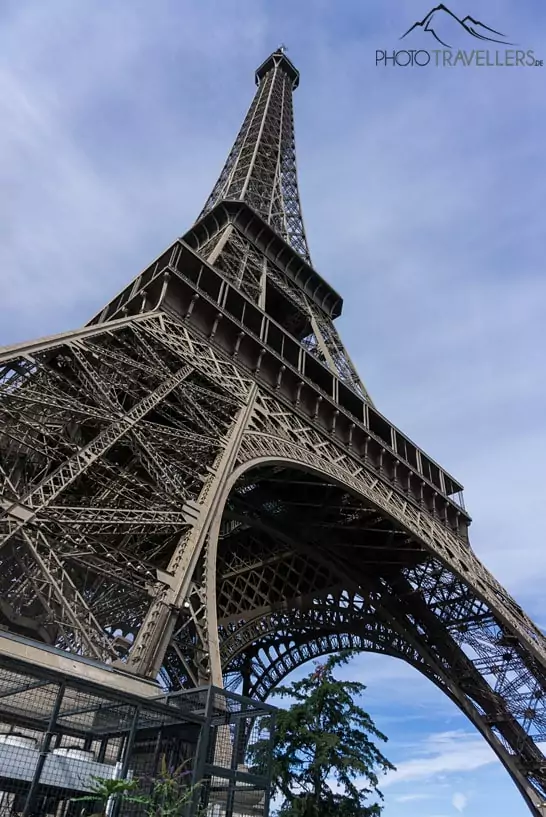
Things to do in Paris: 25 beautiful places you must see
Paris is the city of love. We have been enchanted by its many attractions. Therefore, we would like to introduce you to the most beautiful sights of the city - and these are a few.
By the way, we managed to see all the Parisian sights listed here in four days (but didn't sleep much) and rode around the city a lot on our rental bike. With it, you get really fast from A to B (there are even e-bikes) and you can see on the way many beautiful places to see, that don't stand in any travel guide.
You wonder what you can do in Paris? In this article, we'll show you the top things to do and must-dos in the city that you should visit to really experience Paris. We also have some insider tips and secret places for you. Have fun on your city break in the "ville de l'amour".

Hi! Wir sind Biggi & Flo
Wir nehmen dich als Reisejournalisten mit zu den schönsten Orten der Welt!
Werbehinweis: Alle mit einem * markierten Links sind Werbelinks.
Our top 10 sights in Paris
Here you will find a list of our personal top 10 sights at a glance:
- Eiffel Tower
- Palais de Chaillot
- Musée du Louvre with the Mona Lisa
- Notre-Dame
- Catacombs of Paris
- The Panthéon
- Sainte Chapelle and Conciergierie
- Walk along the Seine
- Champs-Élysées
- Arc de Triomphe
Tip: To explore Paris with its many great sights as cheaply as possible, we recommend the Go City Pass Paris (order here*).
1. The top sight: the Eiffel Tower

The Eiffel Tower is the landmark of the Seine city and of course the top sight to see in Paris. The Eiffel Tower has enchanted me. There it stands suddenly in front of you. A huge colossus of steel. Whether at night or during the day – the Eiffel Tower is always impressive. On the meadow in front of it, the Champ de Mars (Mars Field), there is always something going on. The Eiffel Tower is especially beautiful at night when the colossus is illuminated. This attraction you cannot miss and is of course a must-see during your visit to the French capital.
The Eiffel Tower is 324 meters high and is located on the Champ de Mars near the Seine. More precisely, in the 7th arrondissement – the name of the various districts in Paris. Built from 1887 to 1889, the huge tower was dedicated to the 100th anniversary of the French Revolution.
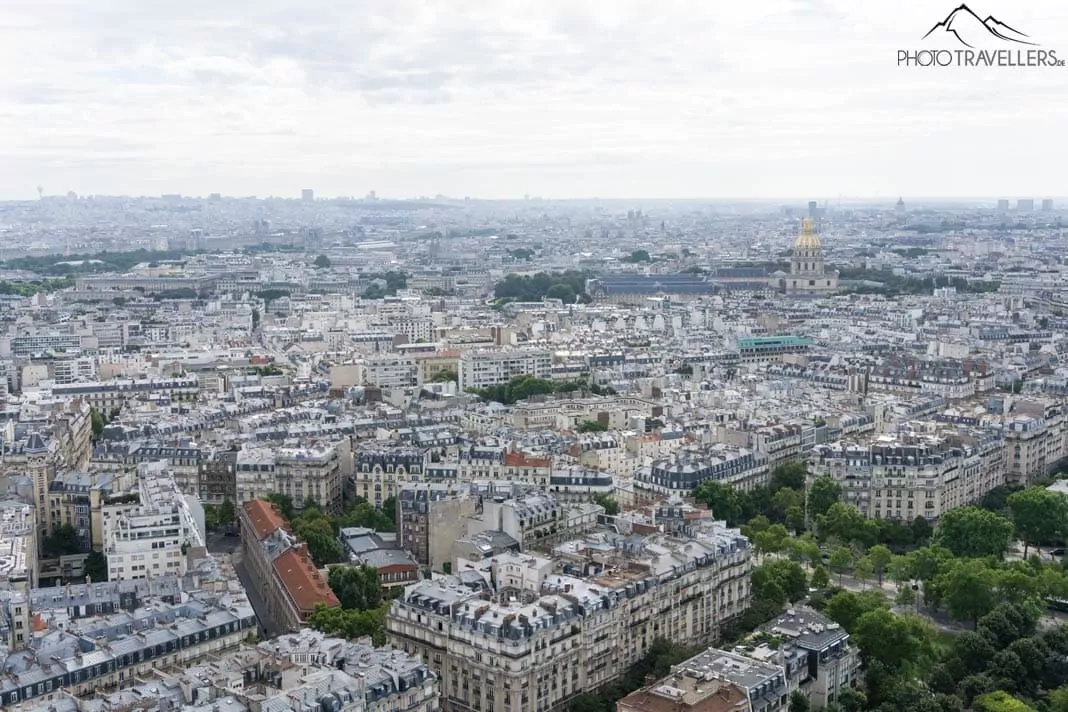
Everything you need to know about the Eiffel Tower, how to save money on your visit, and from where to photograph it best, you can find in our extra article on the Eiffel Tower.
Tip: How about a helicopter flight over Paris (book here*) – that would be the perfect opportunity for a marriage proposal ;-)
2. Palais de Chaillot
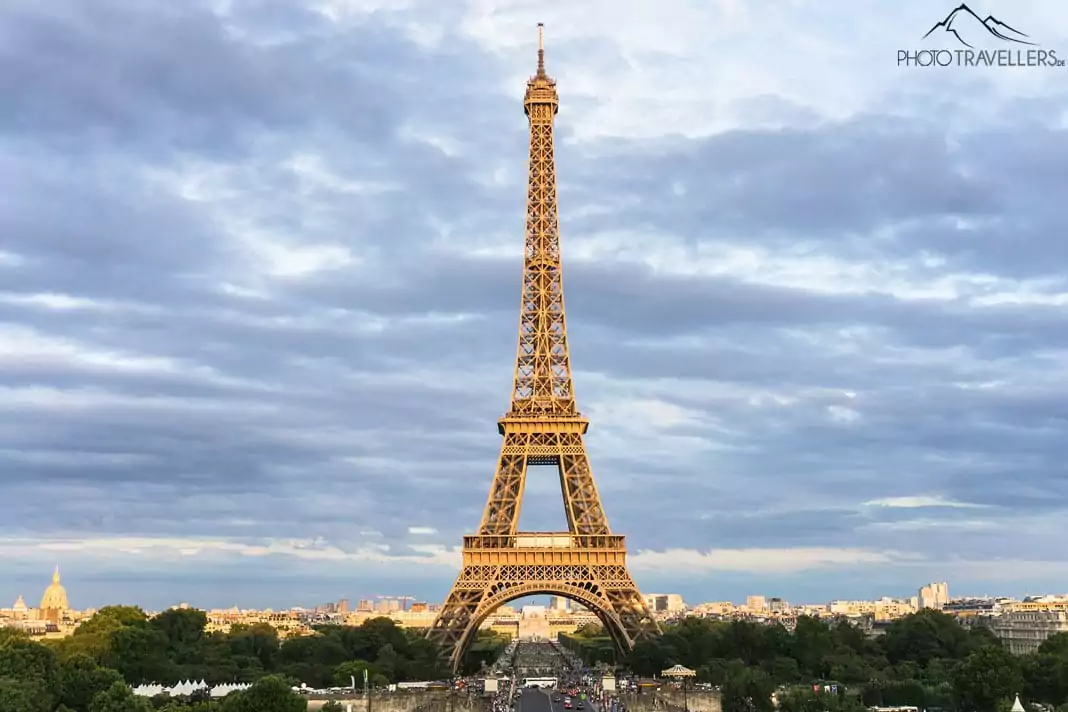
Directly opposite the Eiffel Tower, on the other side of the Seine, is the Palais de Chaillot. In summer, visitors and Parisians sit on many steps and meadows, eat baguettes and drink wine, and enjoy the magnificent view of the metropolis’ landmark. We also have a picnic at the Palais des Chaillot and eat baguette, cheese, avocado, and olives.
From here, you’ll catch the perfect Paris sunset- a place you simply must have seen! In addition, there are always a lot of showmen here for fun and entertainment. At night, the Eiffel Tower is lit up and everything glitters. It looks beautiful. The only thing that is annoying: there are often street vendors who want to sell you something.
By the way, the Palais de Chaillot was built in 1937. From the Eiffel Tower, you can see very well that the Palais consists of two pavilions separated by a large flight of steps. The Palais de Chaillot houses three museums – the Cité de l’Architecture et du Patrimoine, the National Museum of the Navy, and the Musée de l’Homme.
In addition, you’ll also find the Café Carlu restaurant and the Chaillot National Theater. Since the view is best from the top step and you have the Eiffel Tower right in front of you, this spot is of course always crowded. If you stand up here, you may well catch a live marriage proposal.
3. Musée du Louvre with the Mona Lisa
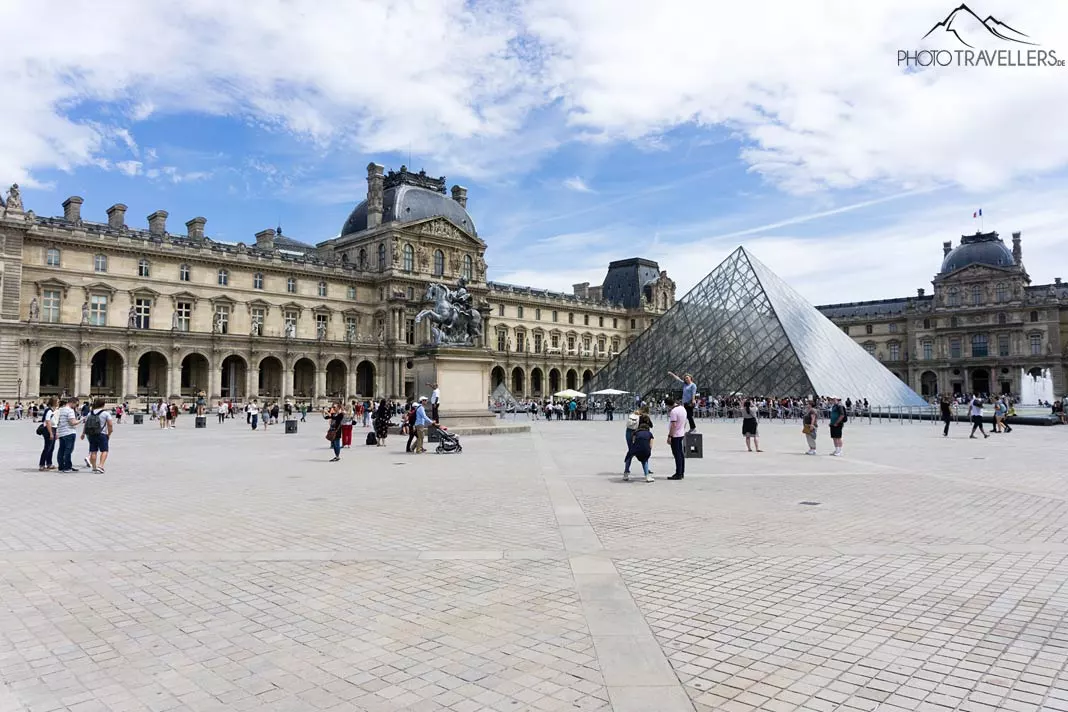
If you’re in Paris, you can’t miss the largest museum in the world. The Louvre is simply impressive and, along with the Eiffel Tower and Notre Dame, is probably the most famous stop on sightseeing tours in Paris. Don’t worry, to really see all the works of art in the Louvre you would need a long time. According to the Dumont travel guide*, it would take you four days if you spent ten seconds looking at each work. No one can do that, and no one should.
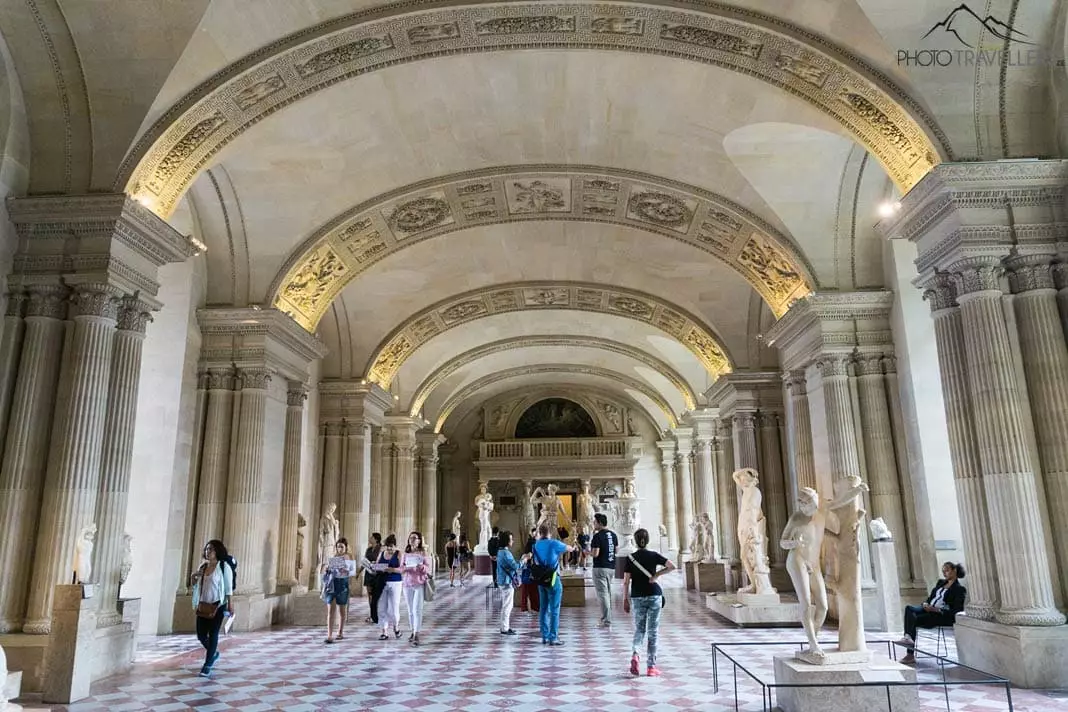
I recommend looking at the different areas on the museum information sheet and then deciding what interests you. Just walking through the corridors makes little sense and you’d probably be oversaturated pretty quickly. After all, there are a seemingly endless number of works on display over 60,000 square meters. The Louvre is an impressive place to go!
Our tip: Buy your tickets for the Louvre in advance online. You have to specify a time window but then you can take the fast lane queue and do not have to wait long. For almost all sights in Paris, it is worth booking tickets in advance. We have never seen queues as long as in Paris before. The city is really bursting at the seams in the summer.
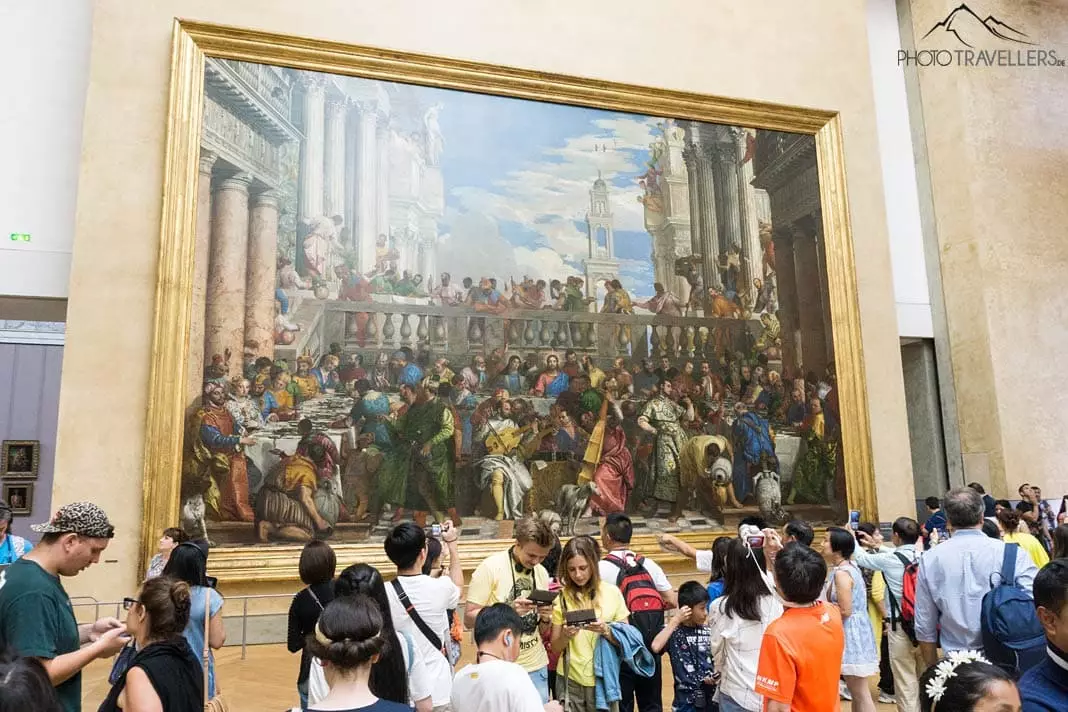
From the outside, the building is also awesome, of course. The glass pyramid and the large palace with an enormous amount of stucco are really beautiful to look at. You’ll stand in front of it and just be amazed. We took hundreds of photos – you won’t feel any different. Never in our lives, we have been to such an impressive museum as the Louvre. The huge paintings, the ancient statues, and the whole architecture of the building – it’s unique in the world.
Mona Lisa (Louvre)
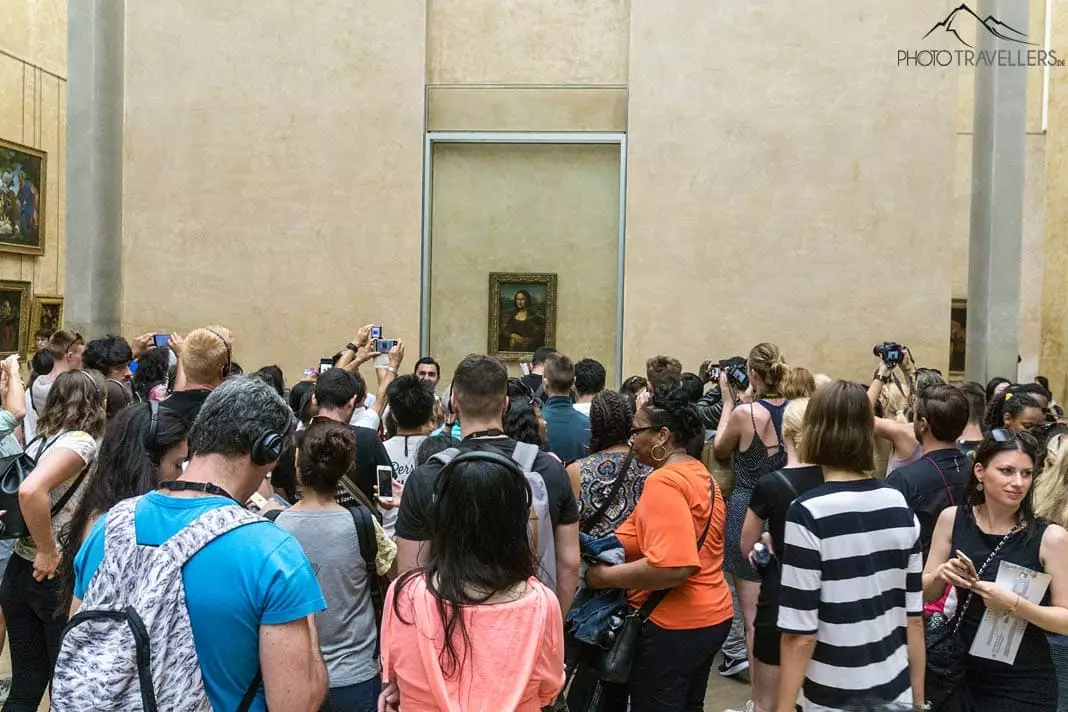
And another thing: Sure, you shouldn’t miss the Mona Lisa in the Louvre either. But don’t be disappointed. The painting of the Mona Lisa is not as big as you might expect. Besides, you will never be alone with the lady. You should have already seen the Mona Lisa – but in your mind, you somehow expect something else beforehand.
Jardin des Tuileries – Louvre Gardens
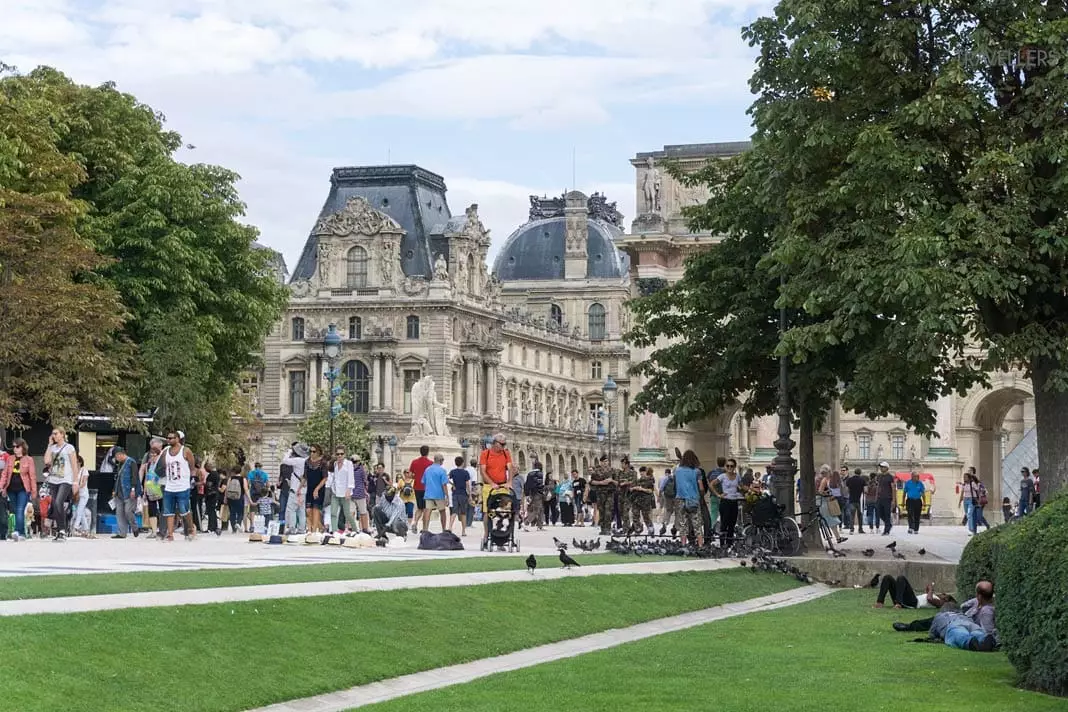
After walking through the Louvre for a long time, we laid outside in the sun on the lawn in the Jardin des Tuileries and enjoyed the weather. These many sights and impressions had to be processed. In addition, we were able to take in the splendor of the palace once again. Then we walked through the Tuileries Gardens.
The park is known as a strolling mile. There are benches and chairs everywhere where you can relax. There are small cafes and snack bars. It’s simply fantastic there. In the gardens, there is also the Musée de l’Orangerie. Among other things, Monet’s water lily paintings, which are worth seeing, are exhibited there. If you haven’t had your fill of art after the Louvre, you can explore further there.
Our travel guide tip for Paris
Well? Are you in the mood for Paris? I love to browse through travel guides. Here I can recommend the Paris Travel Guide: Best things to do and see in Paris (get it here*). You should also have a look at Rick Steves Pocket Paris (get it here*).
4. Notre Dame
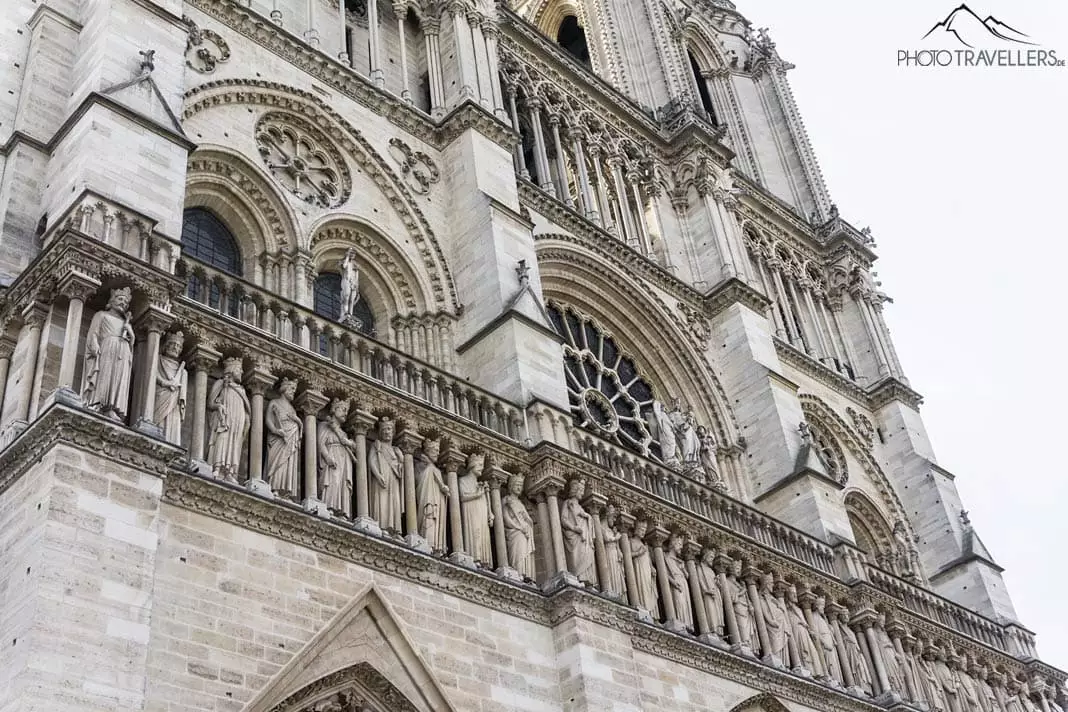
On April 15, 2019, a fire destroyed large parts of the world-famous Notre Dame Cathedral. When Notre Dame can be reopened to visitors is currently not foreseeable. Nevertheless, we show you here the pictures and information about the old Notre Dame. Pictures for the history books.
To see one of the most spectacular Gothic churches, we have a good tip for you. Go to Notre Dame as early as 8 or 8:30 in the morning. After 10 am, you can be sure that a huge line will stretch across the entire square in front of the church. Notre-Dame is located on the Seine island Île de la Cité in the 4th arrondissement of Paris.
The church is also called the Church of Our Lady, which means it’s dedicated to Mary, the Mother of God. Up to 14 million people visit the church every year – that’s an average of almost 40,000 a day. Every visitor to Paris wants to see the inside of the church, which is over 850 years old. So Notre Dame is on every sightseeing list for Paris and is definitely a must-do for your visit to Paris. By the way, the church was completed in 1345. Construction began as early as 1163.
On Sundays for service, it’s also very impressive in the church with organ music and singing. Visitors can still walk around then. The only drawback is that the third rose window in the church to admire is above the organ and can only be seen when you stand in front of the altar. However, this is not possible during the service.
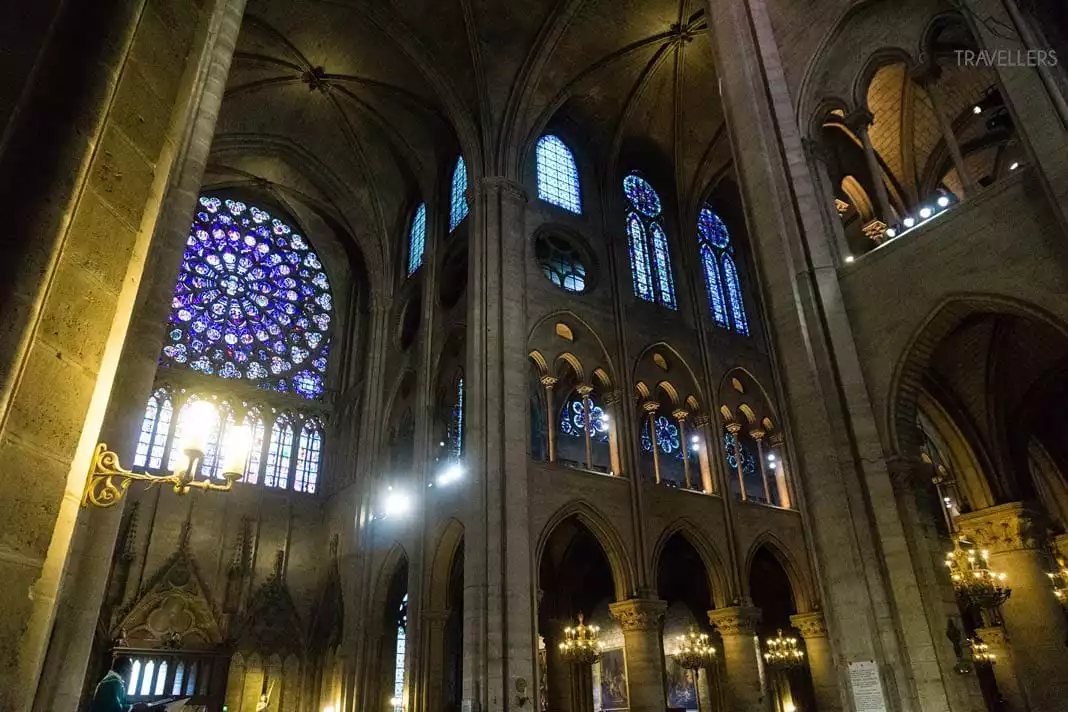
The three rosettes in Notre Dame are simply enormous and beautiful. They are up to 13 meters in diameter. Even though they are so large and are lined with other, smaller rose windows, it is very dark inside the church. But that’s just what makes the church so charming.
The view from the south tower of Notre Dame
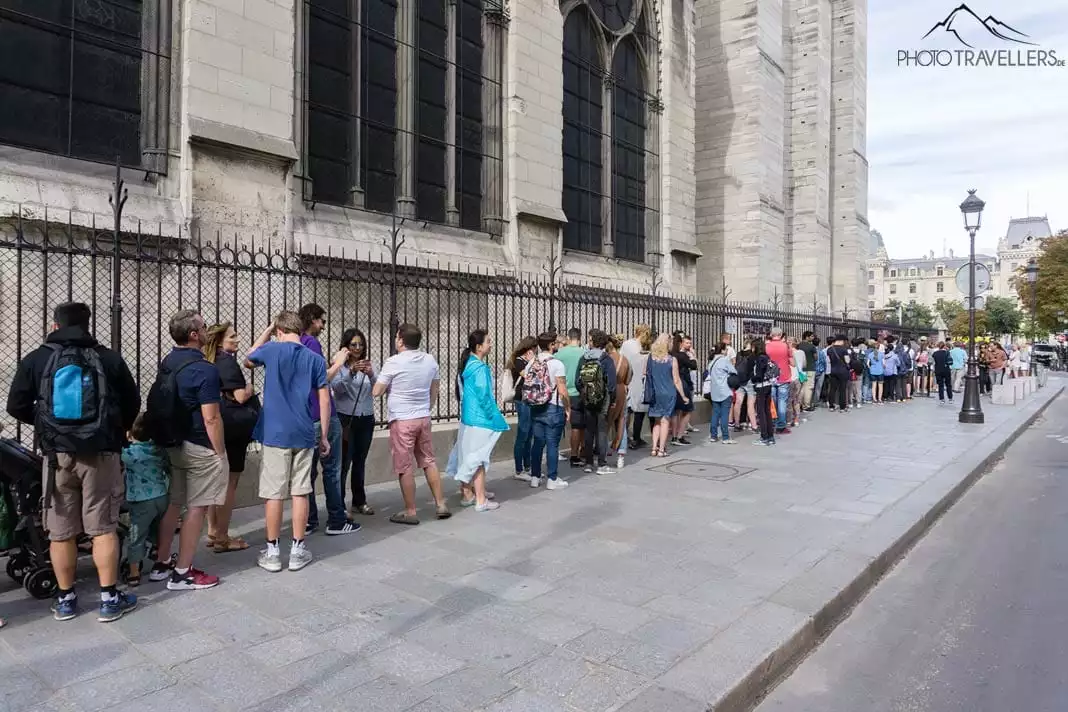
To climb the south tower of Notre Dame, you have to take a ticket with a time on it at the machine left of the entrance and queue at the right time. Since we had a little time between visiting the church in the morning and the first admission to the tower, we had breakfast at Café Panis. This place has a delicious breakfast in a beautiful, original spot in the middle of town.
Back at the entrance, we got a little shock: Within a very short time, a long queue had formed. Luckily we had our tickets at the time. With them, you simply walk past the queue to the entrance at the appropriate time, show them and get in.
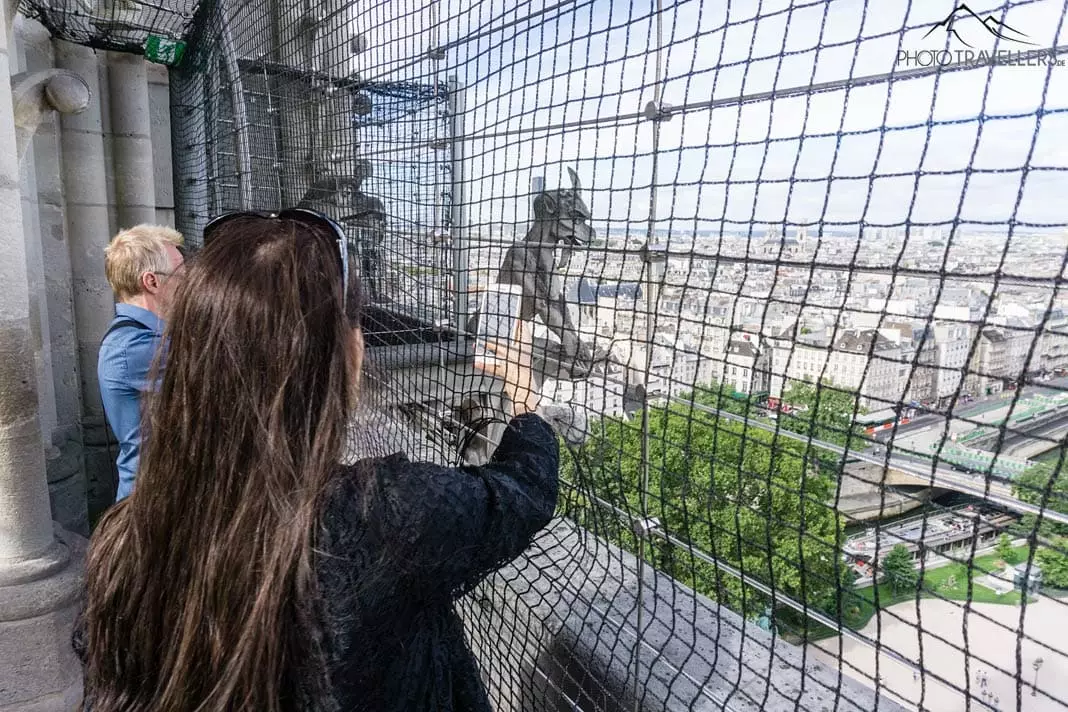
⭐ Tip: Be sure to get a ticket with time at the vending machine (on the side to the left of the main entrance) in the morning before the south tower opens!
400 steps lead up to the roofs of Notre Dame. The stairs of the more than 850-year-old church are already so worn out that it looks as if the steps have holes. From the 69-meter-high tower, a new world opens up to us. Believe me – it is simply breathtaking. You can also take typical photos with the gargoyles without any problems. There is enough time for that.
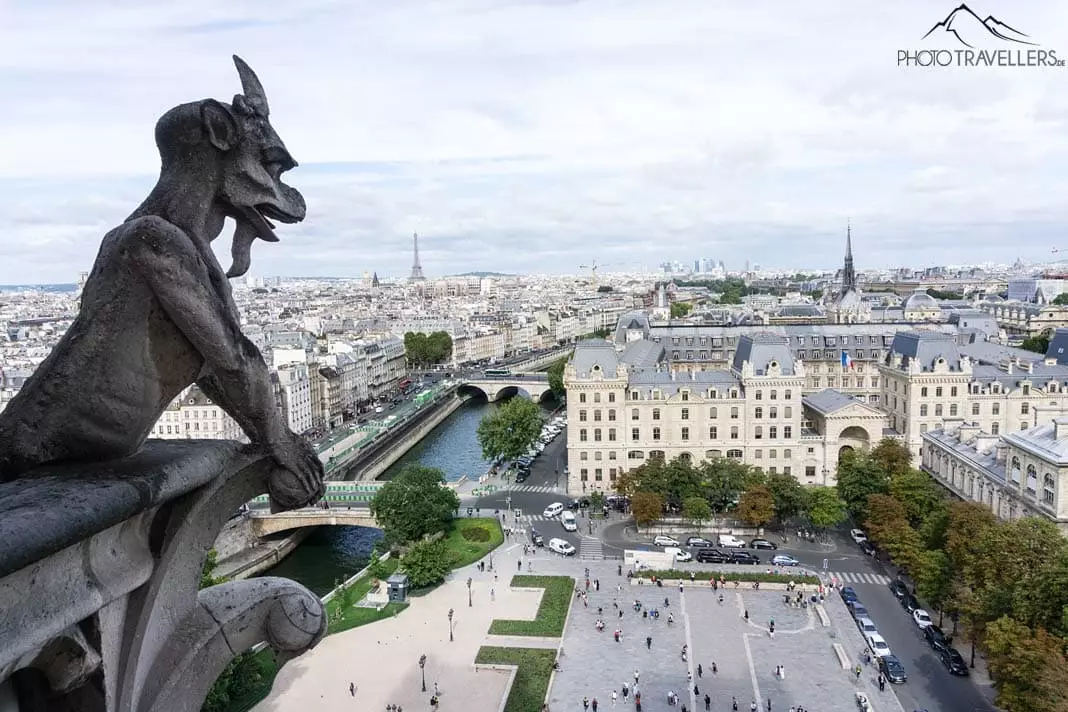
You can’t stay on the tower indefinitely but it’s still worth a visit. The Galerie des Chiméres – the gargoyles with their grotesque grimaces – is a must-see in Paris. By the way, the bell of Notre Dame is called Emanuel and weighs 13 tons. The mallet alone weighs 500 kilos.
5. Catacombs of Paris
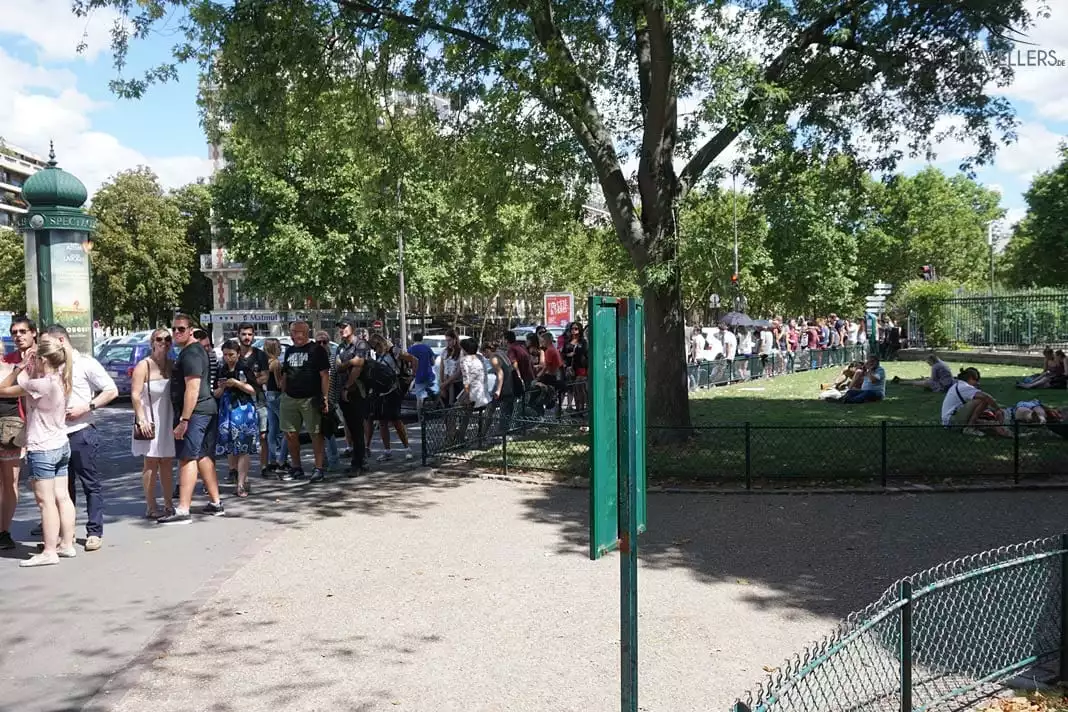
A very special sight with a creepy factor is the catacombs. For centuries, stones, plaster, and clay were mined underground in Paris for the construction of the city. Since the 12th century, underground quarries and networks of tunnels 300 kilometers long were created at depths of five to 35 meters. Thus, the whole of Paris is provided underground with a huge labyrinth. From 1600 onwards, the city tried to refill these massive underground tunnels because the population was afraid of collapse.
By the end of the 18th century, the solution to the problem seemed near. Due to the rapid increase in population, epidemics and famines took hold. Parisian cemeteries quickly filled up. Bestial stench spread. The disastrous conditions became so bad that cemetery heights had to be closed. Starting in 1785, the bones of the dead were transferred to the catacombs. More and more cemeteries were cleared, and more and more bones were placed in the quarries.
Today a small part of the catacombs can be visited. Two kilometers are open to the public and you get a very good historical impression of that time because everything is described in detail. Normally I never use audio guides. Here I was very happy that we could hear the history while walking through the corridors.
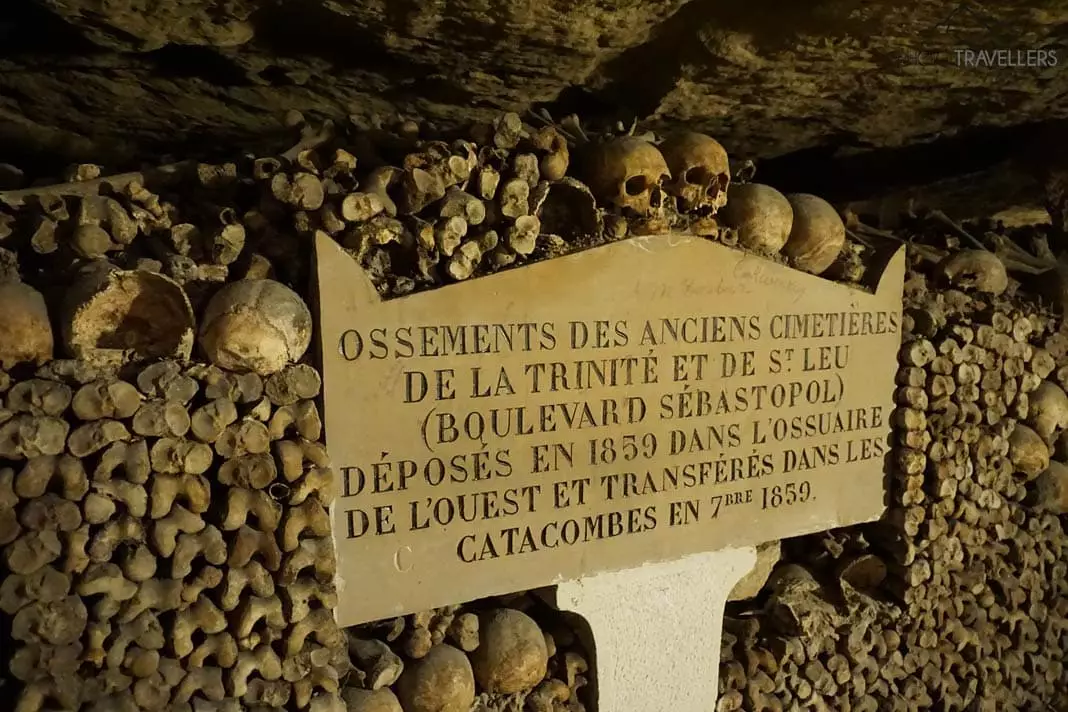
Our tip: We bought our ticket online ahead of time. We picked up the tickets at a kiosk. Everything went smoothly and we were able to get in line in the fast lane. Here, too, we had to wait a while. The “normal” line was a mile long, though. Book the catacombs tour really in advance on the internet, otherwise, you will wait many hours on the street. In that time you can look at other great things.
The entrance is at the Place Denfert-Rochereau. And then the adventure underworld of Paris begins. 130 steps down.
My tip: wear a thin jacket because it’s only 14 degrees. First, you walk through former underground quarries – here I recommend again the audio guide because on the attached boards you do not get as much information as on the guide. And it is really well narrated. It’s a fun thing to do!
The exciting and a bit creepy part are the piled-up bones and skulls you see now. Some skulls are covered with green moss, which looks even more gruesome. The bones have been artfully arranged, which makes the whole thing seem rather unreal. The catacombs are definitely a must-see in Paris. At the end of the tour, it’s back up a few stairs and you’re back in daylight on Rue Rémy Dumoncel to the world of the living.
Another tip: The bus with the number 38 goes to the catacombs.
6. The Panthéon
The Panthéon (Greek for “burial mound”) in the 5th arrondissement is located on the hill of St. Genoveva and is also one of the city’s most famous things to do. The Panthéon is France’s national hall of fame. Many famous Frenchmen rest here. King Louis XV once became seriously ill and promised to build a church on the Montagne Sainte-Geneviève if he recovered.
The architectural model is the Pantheon in Rome. Under the church, there is a huge system of corridors where chapels were built. Here are buried, for example, the French philosopher and writer Voltaire, the famous chemist and physicist Marie Curie, writer Alexandre Dumas and philosopher Jean-Jacques Rousseau. Not buried in the Panthéon are Napoleon Bonaparte (he lies in the Dôme des Invalides) and Charles de Gaulle.
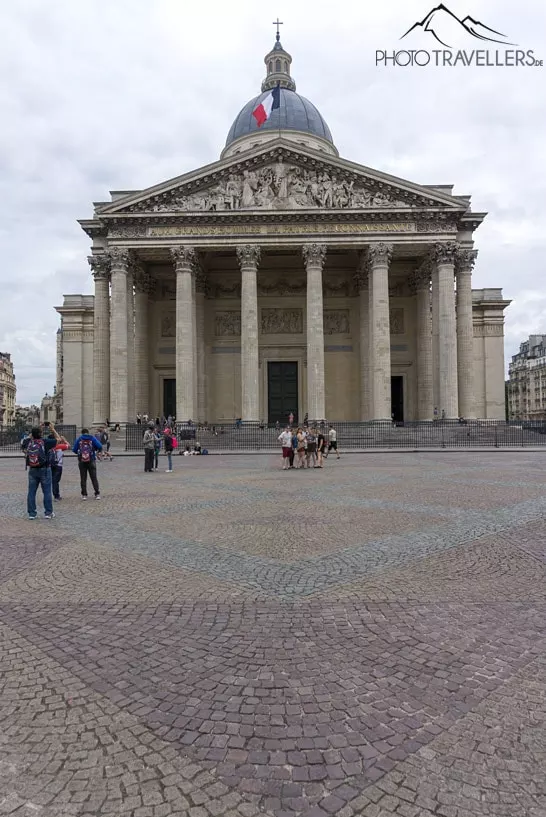
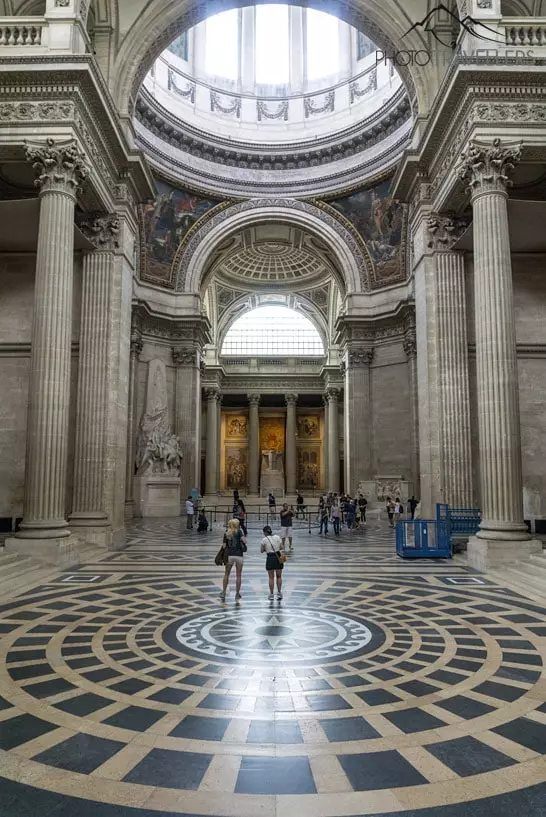
The Panthéon is extremely impressive. The Greco-Roman temple facade is simply enormous. You could spend hours here. Inside, not only are the meter-high columns fascinating but also the great paintings on the walls.
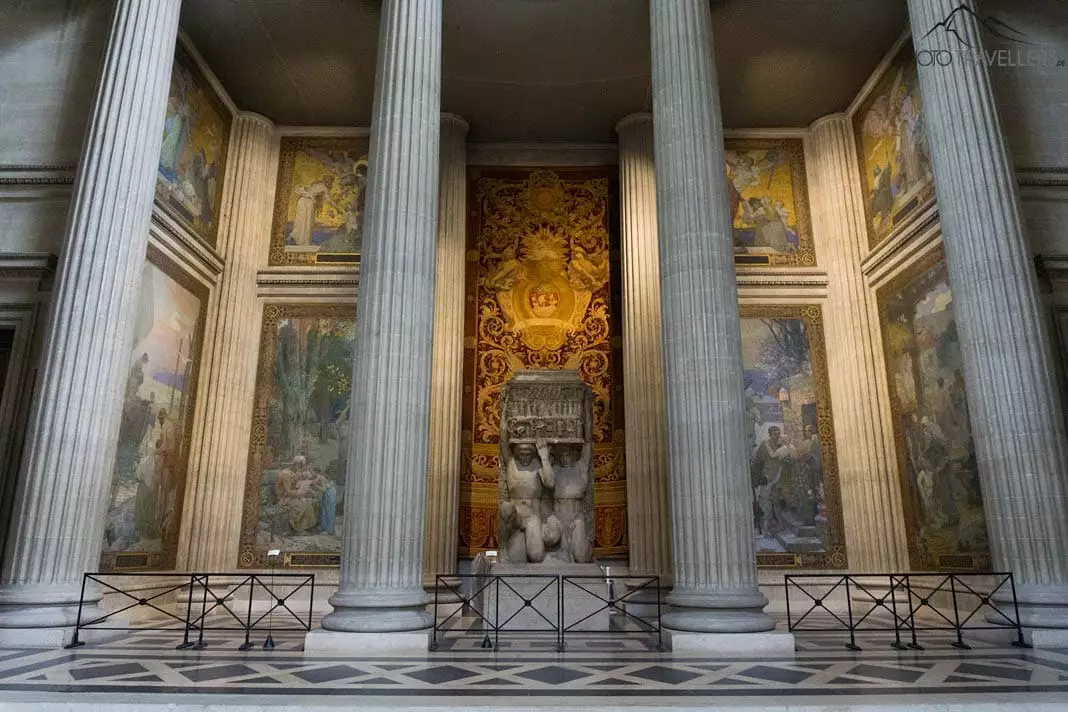
Huge domes let some light into the otherwise rather gloomy building. An absolute highlight in the Panthéon is the Foucault pendulum. In 1851, the physicist Jean Bernard León Foucault used a pendulum to prove the rotation of the earth (but similar experiments had been done long before). To demonstrate the experiment to the public, a huge pendulum (67 meters) was erected in the Panthéon that same year. Since then, the pendulum has captivated visitors. You should have seen it in Paris.
Our tip: For two euros, you can climb the dome of the Panthéon.
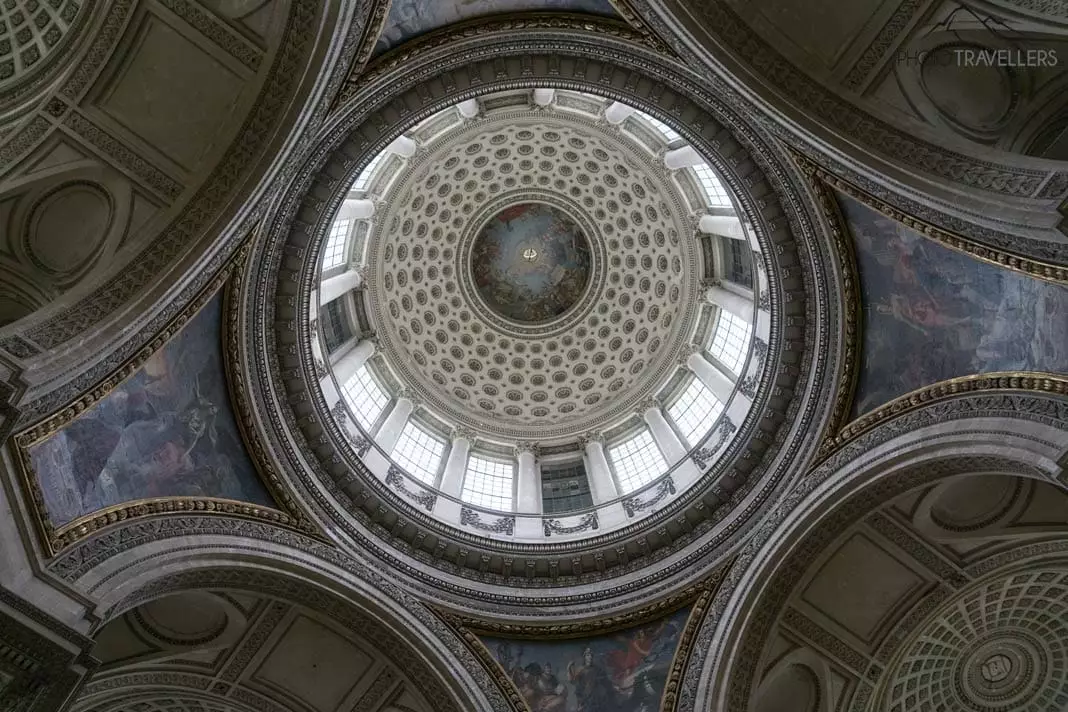
7. Sainte Chapelle and Conciergerie
On the Île de la Cité there are two extremely worthwhile things to do in Paris. One is the former palace chapel of the former royal residence Sainte Chapelle, built-in high Gothic style. The former palace chapel was built in the 13th century and is beautiful. It was intended to keep the relics of the Passion from the Crusade.
The chapel is surrounded by extremely precious stained glass windows, which can be seen from the outside as well. The chapel is said to contain Christ’s crown of thorns, parts of the “True Cross”, and the tip of a lance that is said to have belonged to a Roman captain.
However, we did not go inside the church because it was very busy and we did not have time to queue. Only after the fact did we see what we missed. On our next trip to Paris, the Sainte Chapelle is high on the to-do list.
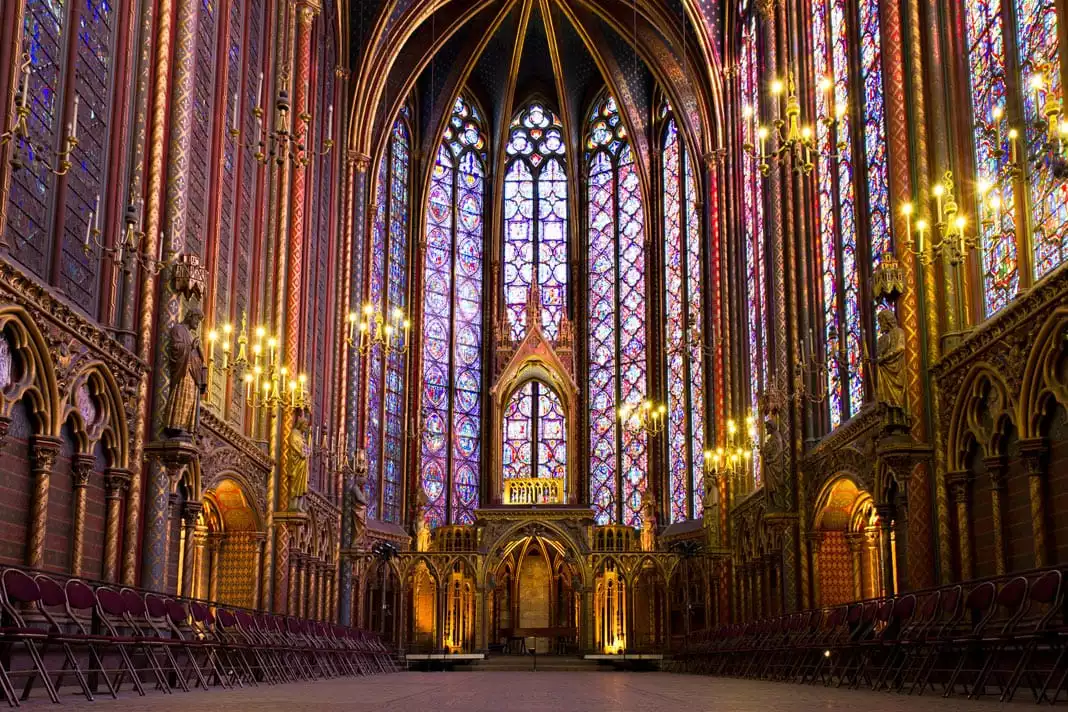
The other building is the Conciergerie, once the royal castle. From the other side of the Seine, the building is very impressive to look at and the magnificence of the complete structure can only be truly appreciated. Starting in the 15th century, the Conciergerie served as a prison. Well-known inmates were Marie-Antoinette and Robespierre. Their cells as well as other rooms can be visited.
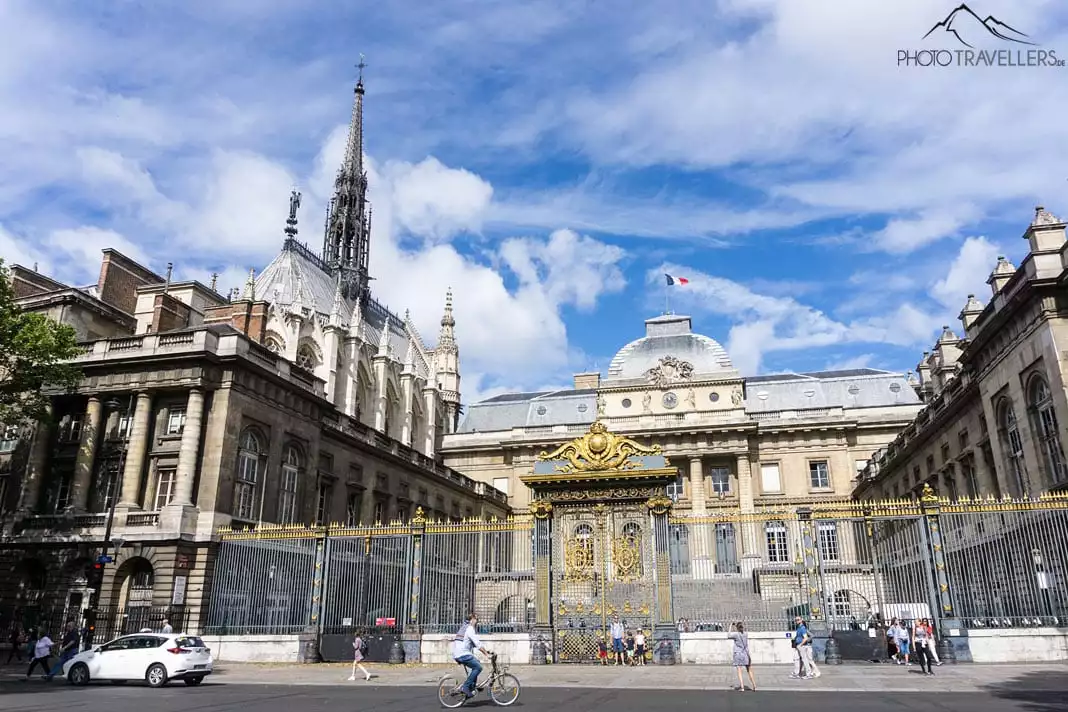
Nearby is also the Fontaine Saint-Michel. The fountain was built in 1860. On display is the Archangel Michael fighting the devil. If you happen to be in the area, it’s worth a detour.
8. Walk along the Seine
In summer, the banks of the Seine are a huge promenade with deck chairs on the lawn and plenty of picnic opportunities. Parisians have made themselves comfortable in loungers, small bars are open.
A musician with his incredibly great rough voice sings “what a wonderful world”. With a beer in hand, we sit and listen to his music. Deceleration is also important on a city trip. It’s also very romantic. An extended walk along the Seine is a fantastic thing to do on any Paris trip.
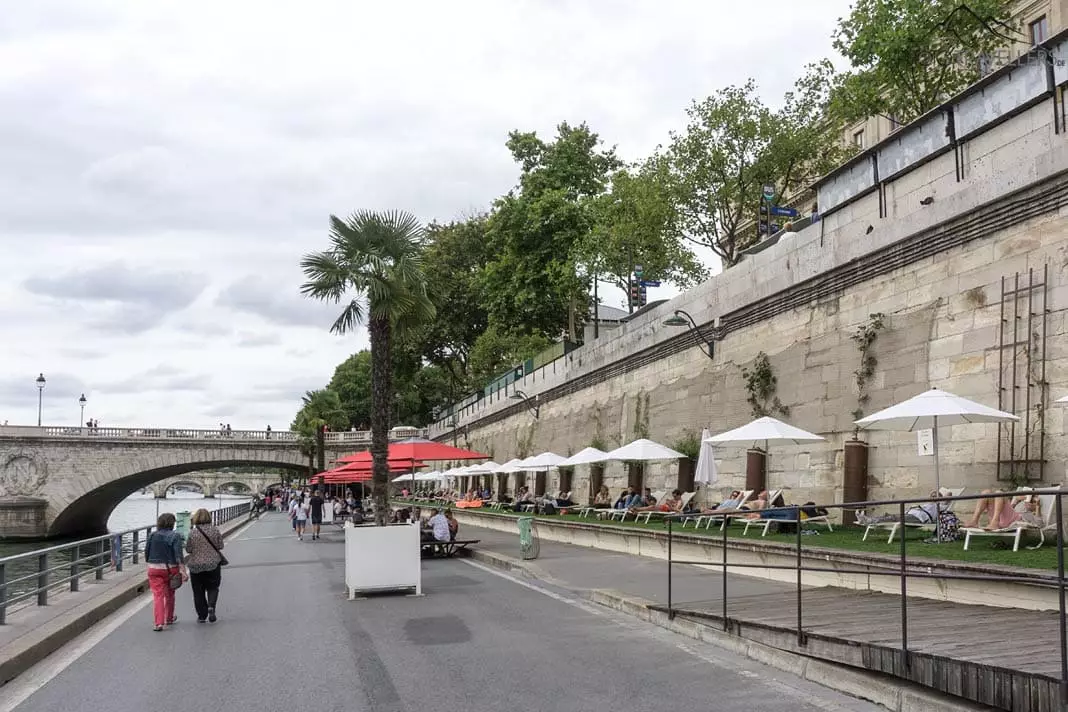
9. Champs-Élysées
Do you also have the earworm to the matching song in your ear right away? “Aux Champs-Élysées, aux Champs-Élysées…” No wonder I kept whistling this song on my bike.
The Champs-Élysées stands as one of the most famous streets in the world and as one of the top sights in every travel guide.
Well, the street is not really beautiful (at least we did not like it) – but it is an experience to stroll along here.
All well-known and especially expensive fashion brands have a store here. The boulevard is 70 meters wide and 1.9 kilometers long. It starts at the Arc de Triomphe (Place Charles-de-Gaulle) and ends at the Place de la Concorde – another cool thing to do in Paris. The Champs-Élysées is also the place where the big military parade takes place every year on July 14, and it is also the finish line of the Tour de France.
In any case, you should go window shopping on the Champs-Élysées and check out the expensive stores. It’s worth it. They look really great and are decorated with a lot of love. Visit Café Ladurée: here you can get the most delicious macarons in the city.
On the Champs-Élysées is one of the oldest perfume houses in the world: Guerlain was founded in 1828. Since 2014, the store also has its own spa. Otherwise, you have to check out the expensive side streets. Here you can find Gucci and Co.
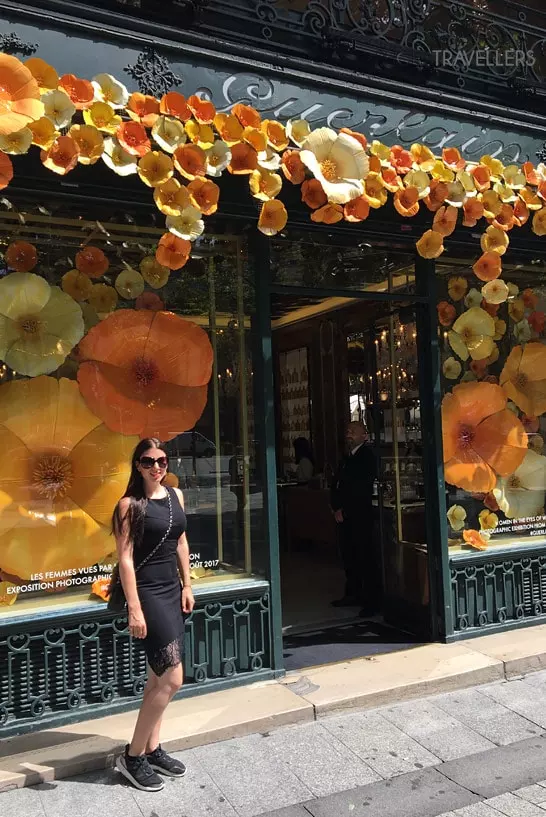
10. Arc de Triomphe
The Arc de Triomphe is also a must on any sightseeing list. This impressive triumphal arch is located on a traffic circle island where twelve streets meet in a star shape. The archway is truly immense but that’s no wonder. After all, it is the largest archway in the world.
It was built in 1806 at the behest of Napoleon. It stands for his victory at Austerlitz. Every evening at about 6:30 p.m., a fire is lit under the arch at a grave. Which soldier is buried there is not known. You can climb up to the archway, the terrace is 50 meters high after all. The view of the Champs-Élysées and the city is absolutely worth seeing. There is also a museum inside. A visit here is a great thing to do!
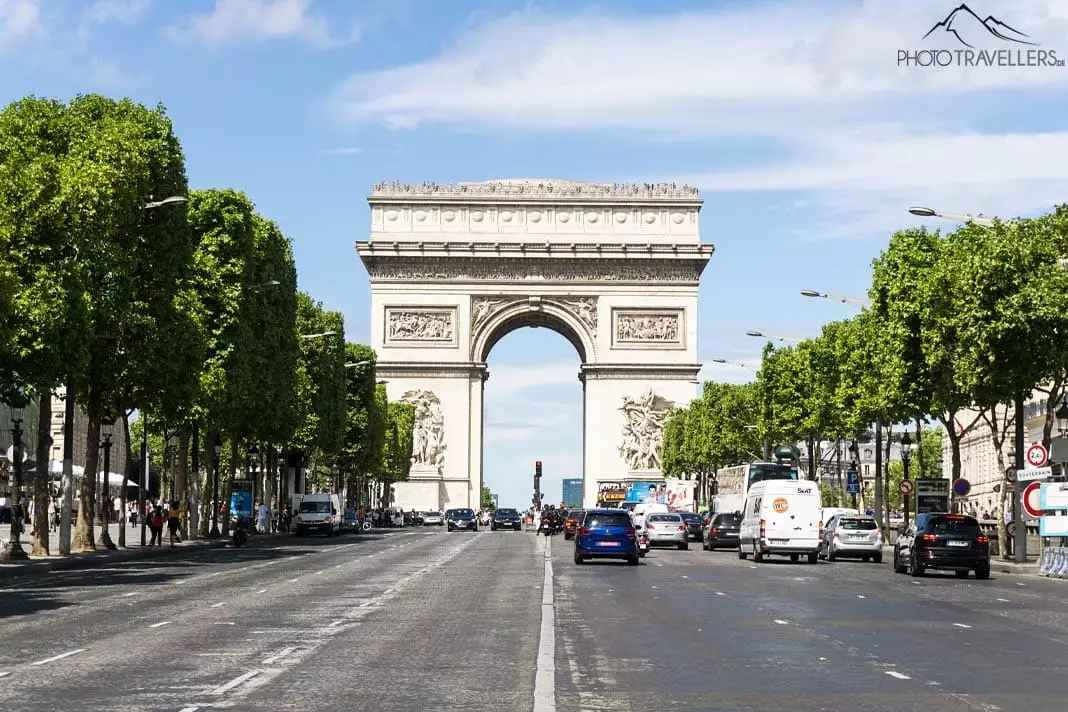
11. Place de la Concorde
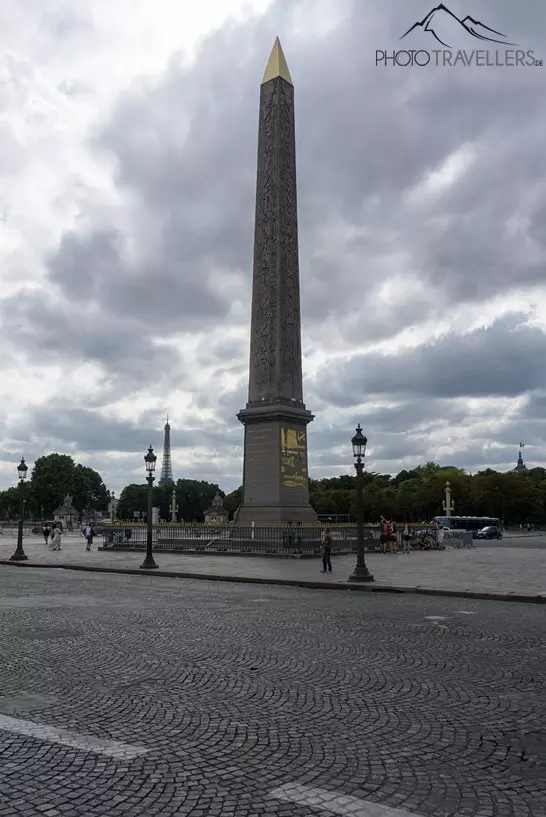
The Place de la Concorde (Place of Concord) is the largest square in Paris and the second largest in France. For that reason alone, the square is a must-do.
The Luxor obelisk, visible from afar, is striking. The 23-meter high obelisk dates back to the 13th century BC and once adorned the temple of Luxor. On October 25, 1836, the obelisk was erected on the Place de la Concorde.
Incidentally, the Place de la Concorde has had many names throughout history: including Place de la Révolution and Place Louis XV.
The old names already suggest it: the Place de la Concorde is extremely steeped in history. On January 21, 1793, for example, Louis XVI was beheaded here, and in October of the same year his wife Queen Marie Antoinette.
The following year, revolutionaries Georges Danton and Maximilien de Robespierre were executed in the square. In total, more than 1300 people were executed in the square during the French Revolution.
Beautiful is also the two huge fountains – inaugurated on May 1, 1840 – on the Place de la Concorde. Around the square, there are also 20 cast light poles (candelabra) and eight statues of women symbolizing the eight largest cities in France. A visit to the fountains is a great thing to do here!
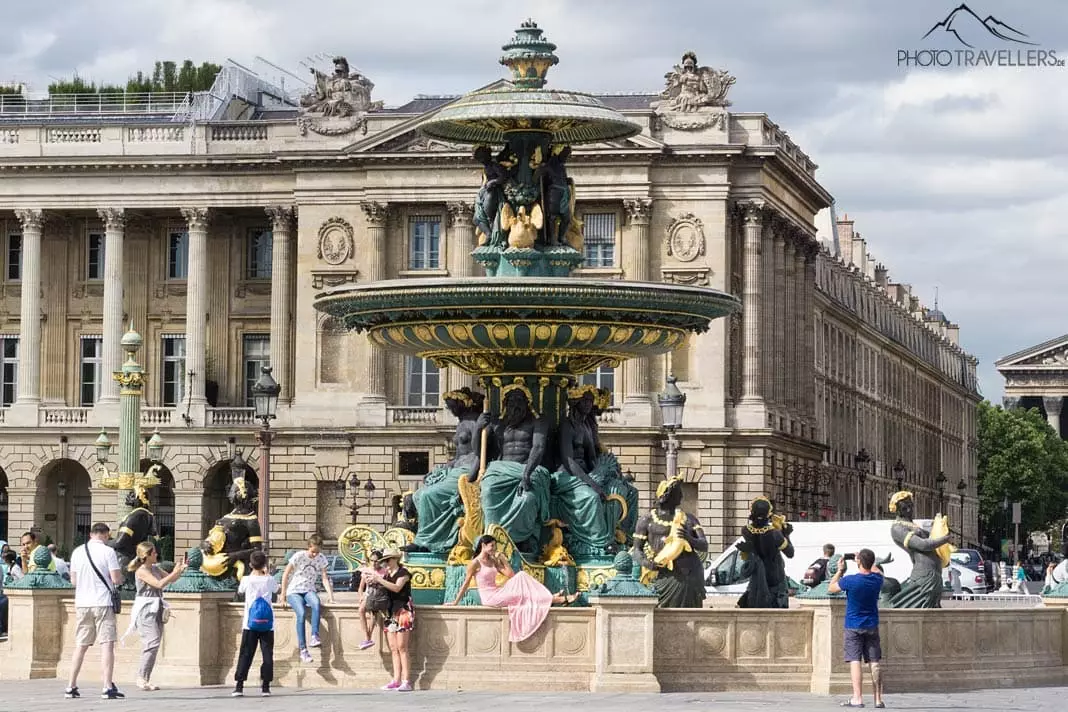

12. Centre Pompidou
If you’ve been impressed by the great buildings and history-filled sights in Paris so far, you’re in for a culture shock now. The Centre Pompidou is quite different – and still one of the top things to do in the city. In the middle of the city stands a large block with colorful pipes on its outer facade. Sure, the Centre Pompidou is eye-catching and fits the theme of modern art. Architecturally, the whole thing looks like a giant refinery.
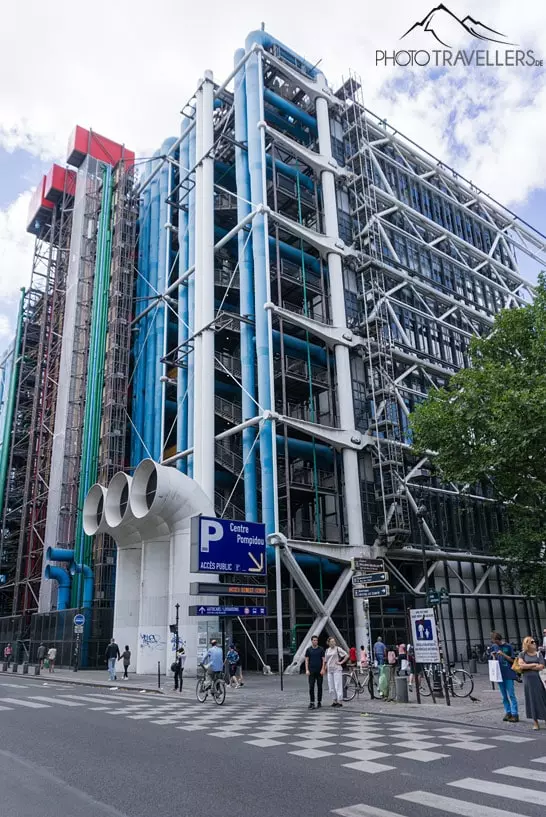
When the Centre Pompidou opened in 1977, it was quickly named the Culture Factory. The colossus is 42 meters high. 25,000 people come every day to see the art exhibitions. On the main side of the building, there is a huge transparent tube. You can go up several floors on the escalator and get a bird’s eye view of Paris.
From the top, you look over the Parisian rooftops, which are very characteristic. On top of the larger chimneys are small chimneys that give the roofs a very special look.
Our tip: If you don’t have time for the museum, you should at least buy a ticket for the escalator and enjoy the view. The “View of Paris” ticket costs five euros (as of July 2018). By the way, there is also a restaurant with a roof terrace at the top.
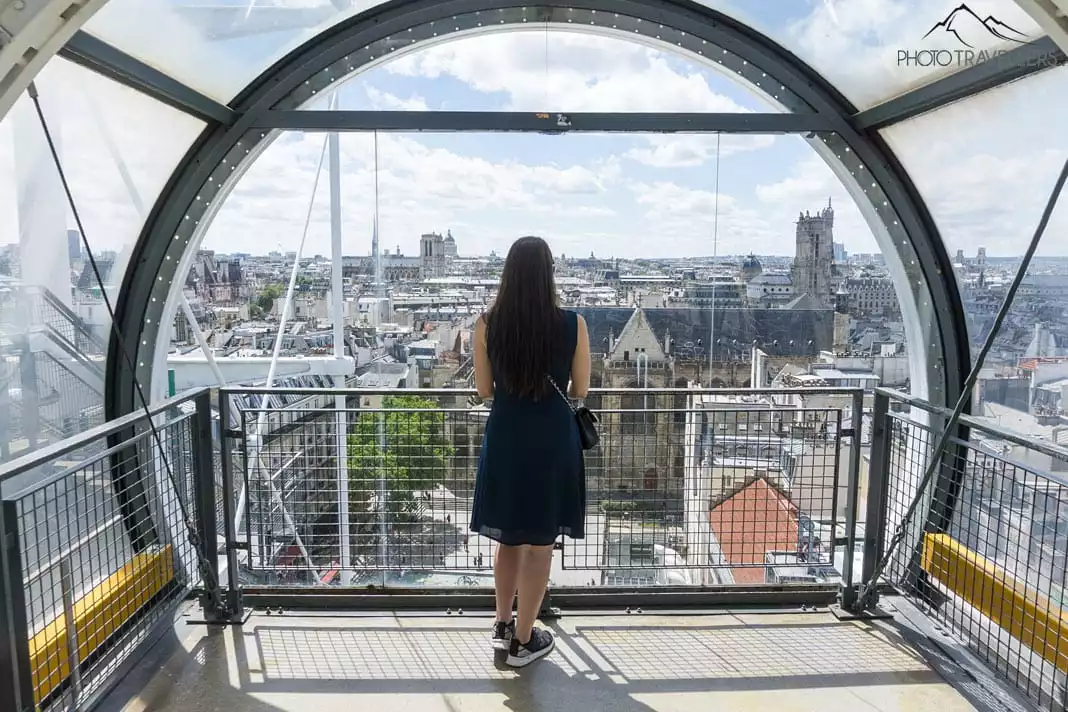
13. Stravinsky Fountain
Right next to the Centre Pompidou is the Stravinsky Fountain. 16 individual sculptures are placed in the fountain and each one looks different and funny. Niki de Saint-Phalle and Jean Tinguely are the artists who created and made them. When you visit the Centre Pompidou, you almost automatically pass by the fountain. However, the fountain alone is not necessarily worth a detour.
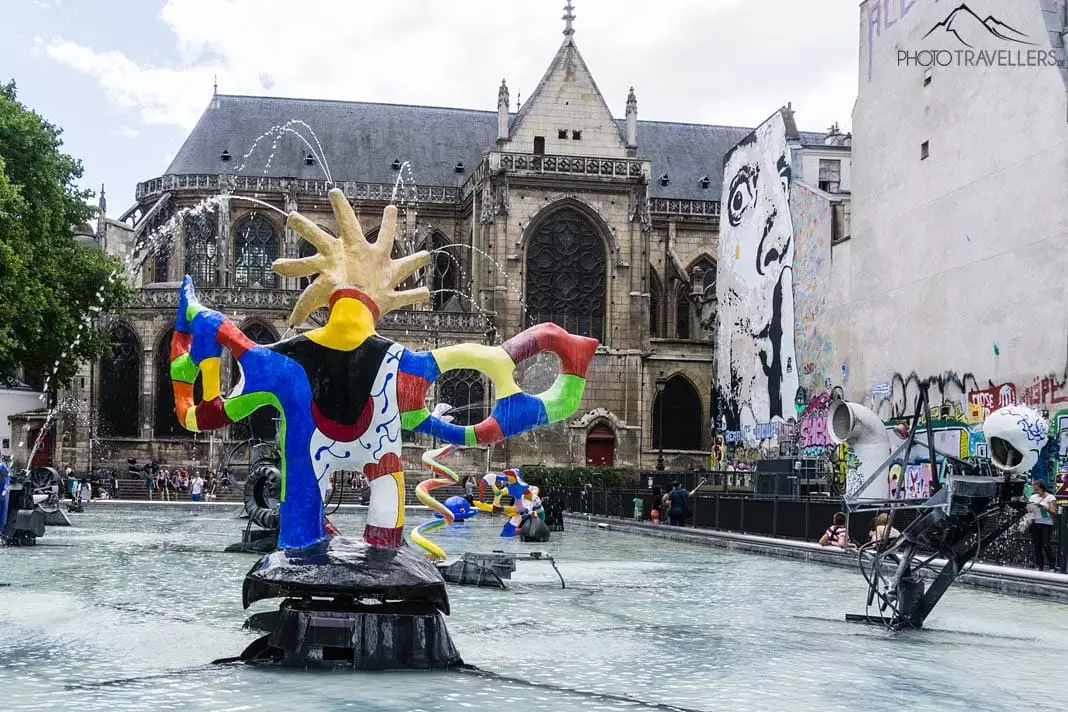
14. Montmartre
What you also can’t miss is Montmartre. The hill is 130 meters high, making it the highest natural elevation in Paris. To get to the top of the hill, you can either walk up through the small streets or start at the stairs. More precisely at the Square Louise Michel.
From the bottom, you can already see the famous Basilica minor Sacré-Cœur de Montmartre. It stands on the top of the hill. The stairs are beautifully laid out, serve as a photo motif for tourists and invite you to linger in the best weather. Those who can’t or don’t want to walk up the stairs can use the Funiculaire de Montmartre funicular, which goes directly up to the basilica. The view of the city is gigantic.
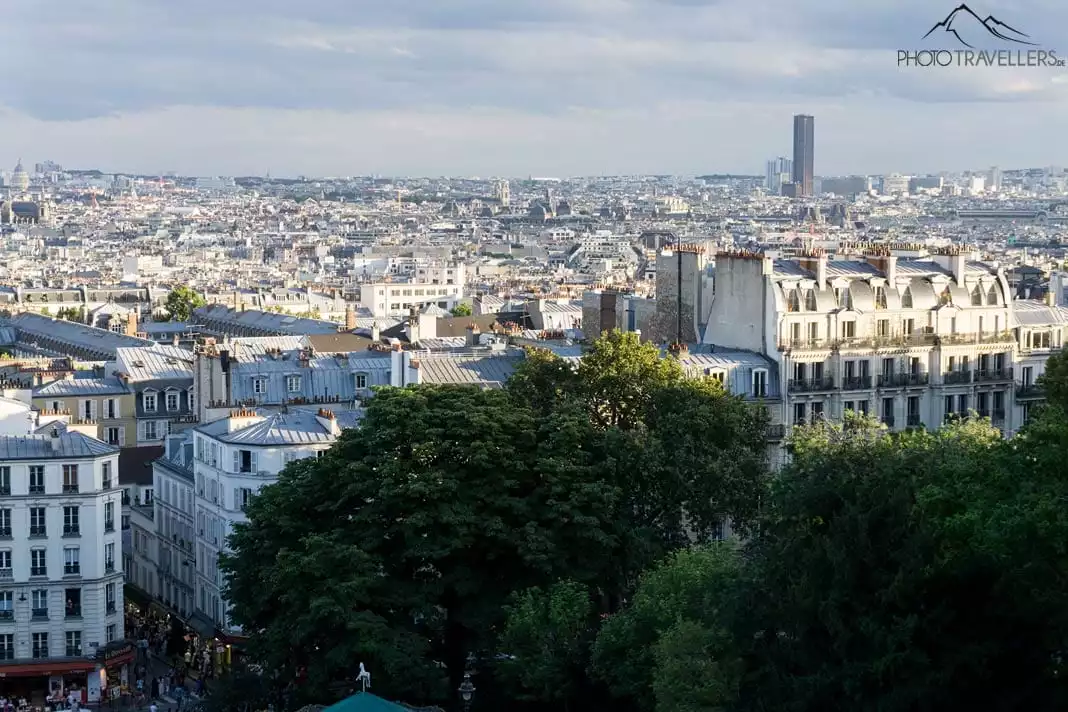
We still walked through the small alleys at Place du Tertre. Here you see street painters offering their portrait arts, artists, and really nice little cafes and eateries. The whole place seems enchanted, and is somehow not quite of this world. You immediately feel at home and want to sit down at one of the little tables and watch the hustle and bustle of the street. You definitely have to put a visit on your to-do list.
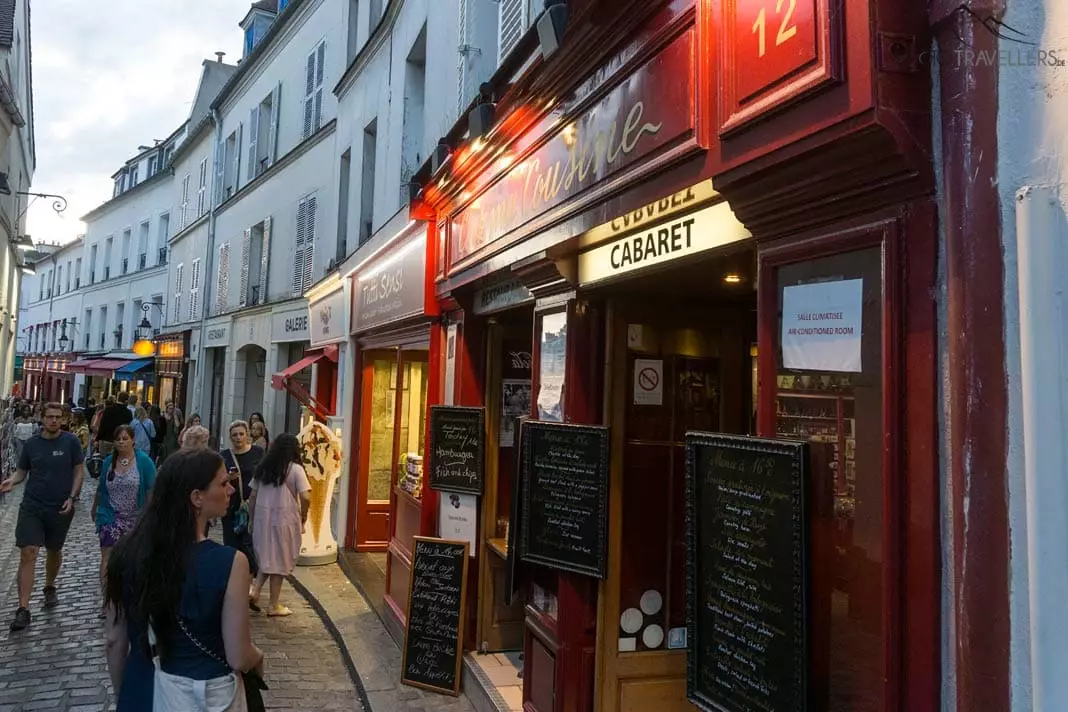
Of course, this corner is also a bit crowded. But if you turn into one of the side streets, it gets quieter. We walked back down the hill a bit at the other end after our visit to the Sacré-Cœur and sat there overlooking the vineyards and enjoyed our baguette, wine, and cheese. The sunset was just beautiful. Along the way we had great live music from the surrounding smaller restaurants and cabarets. For us, one of the most beautiful places in all of Paris.
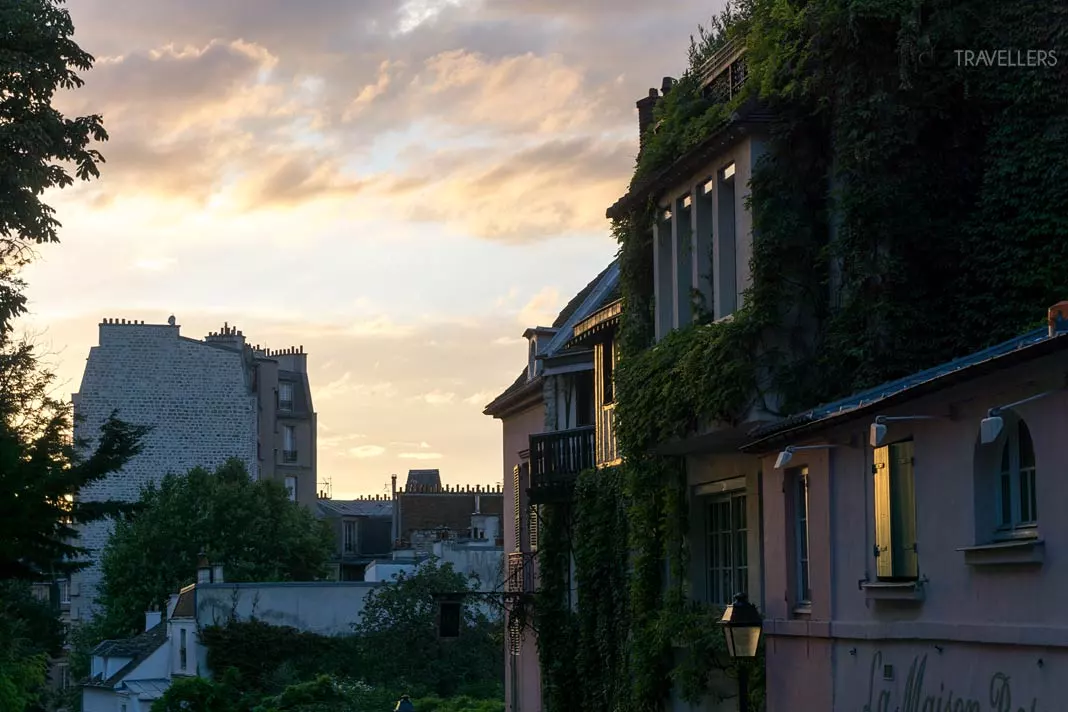
Our tip: walk the small streets of Montmartre in the evening. It will hopefully enchant you as much as it did us. On Rue des Abbesses, we sat down in a little bar – Le Village. Here the DJ is still spinning records. In the balmy summer night, we sat on the street for a long time with a glass of wine and baguette, soaking up the atmosphere around us. There’s really something about balmy summer nights in Montmartre.
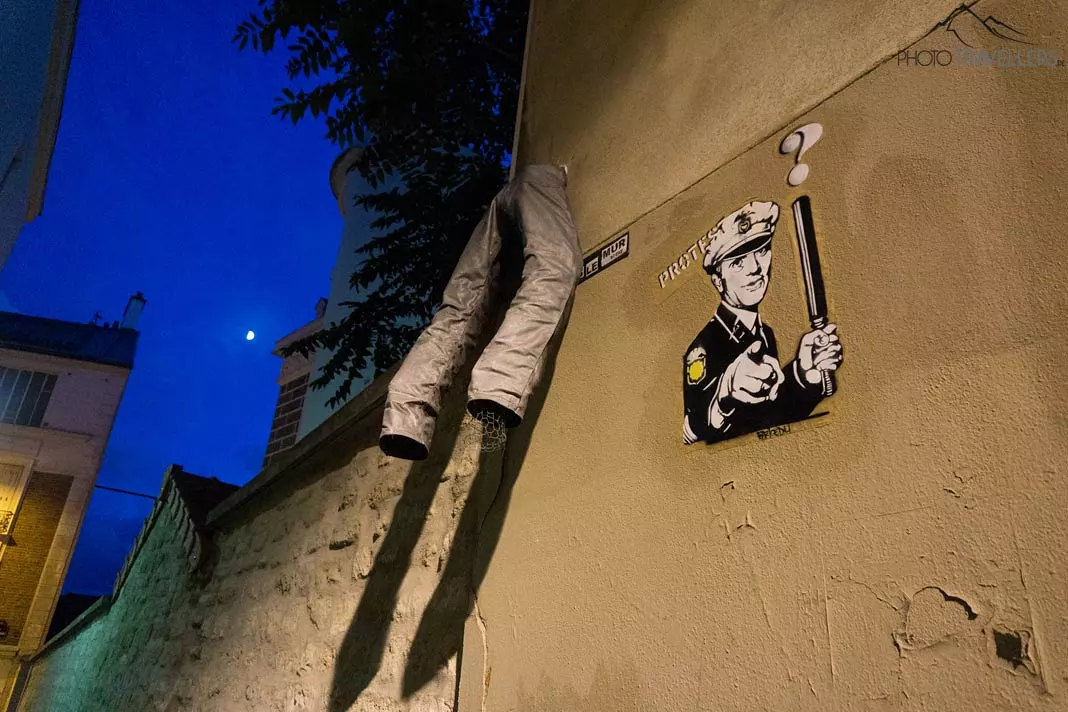
Another tip: at Place des Abbesses is also Le mur des je t’aime – a wall on which love sayings and expressions are written in 300 languages.
15. Basilica Sacré-Cœur (Montmartre)
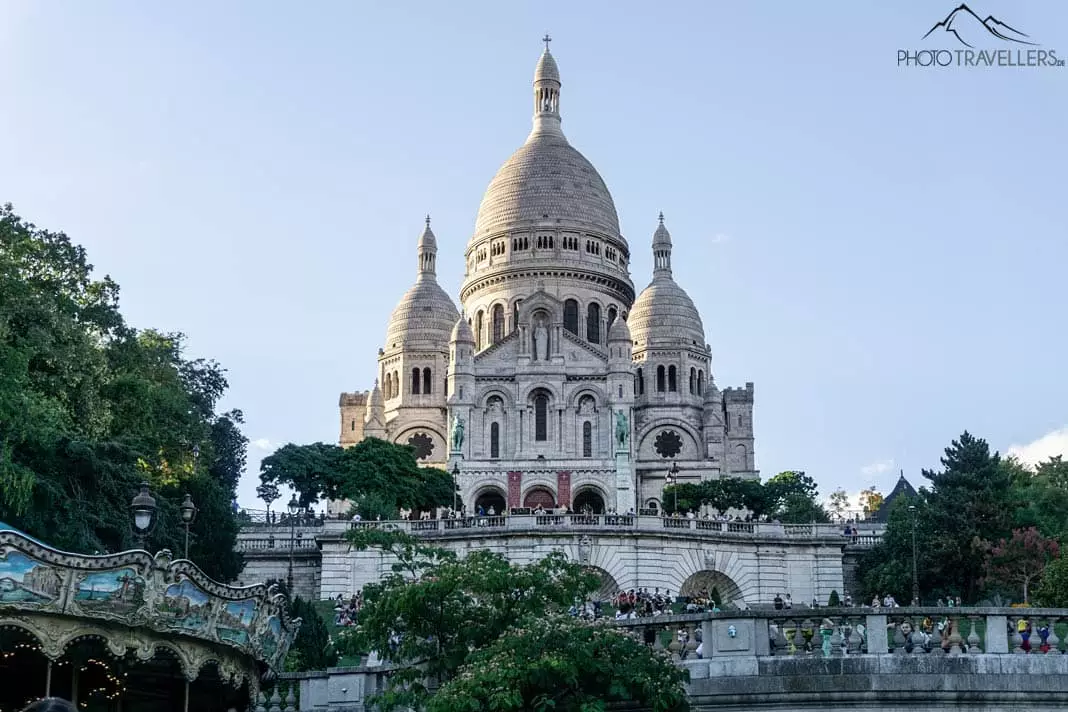
The Basilica Sacré-Cœur is visible from afar as a landmark of the city and one of the most famous things to do in Paris. The white church on Montmartre is extremely imposing. In 1873, it was decided to build it in memory of the French victims of the Franco-Prussian War.
In 1919, it was finally consecrated. Inside, the church is as grandiose as it is from the outside. Above the altar is a beautiful ceiling painting depicting Jesus. In the center, the huge dome illuminates the church. The paintings in the side aisles are also great. Each dome ceiling is also painted with a great picture.
The Sacré-Cœur is not to be missed on your sightseeing trip through Paris and is clearly one of the must-sees of the city.
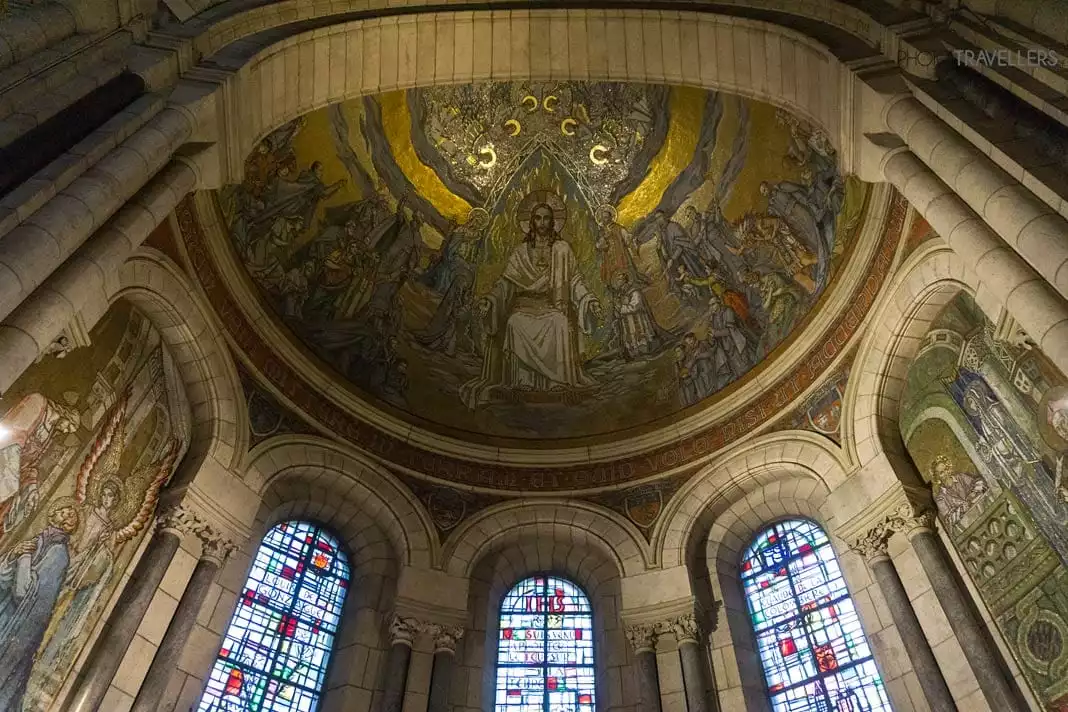
16. Moulin Rouge
Very close to the Sacré-Cœur Basilica, the famous Moulin Rouge on Boulevard de Clichy catches the eye – a Parisian institution with history. The house with the mill has existed in its cabaret form since 1889, and since then events have been held in the variety show every evening. A visit is one of the highlights of Parisian nightlife.
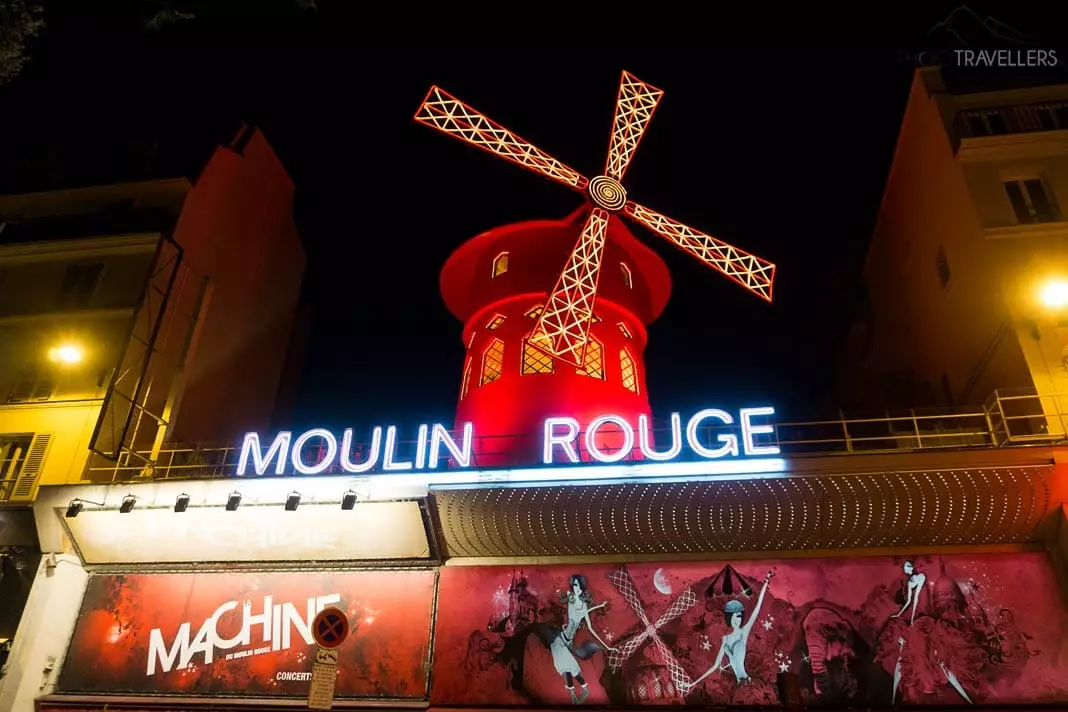
The famous evening shows cost between 80 and over 400 euros per ticket. The dress code is chic. Champagne is drunk. The Moulin Rouge is considered the world’s largest single buyer of champagne.
17. Grand Palais, Petit Palais and Pont Alexandre III
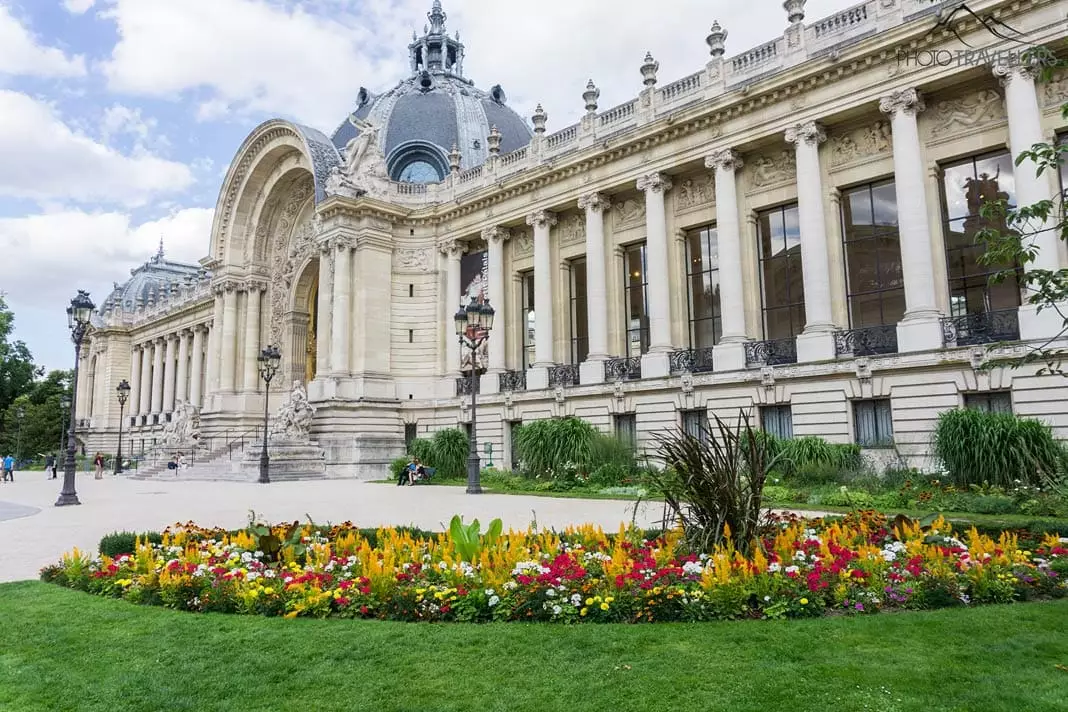
The Grand Palais and the Petit Palais are also worth seeing. You must not miss these buildings and the adjacent Pont Alexandre III because they are among the highlights of the capital. By the way, the Grand Palais was built for the World Exhibition in 1900.
Together, these three important buildings belong to the Belle Époque – this is the beautiful era, which revolves around the turn of the 19th to the 20th century. Today, the palaces host temporary exhibitions.
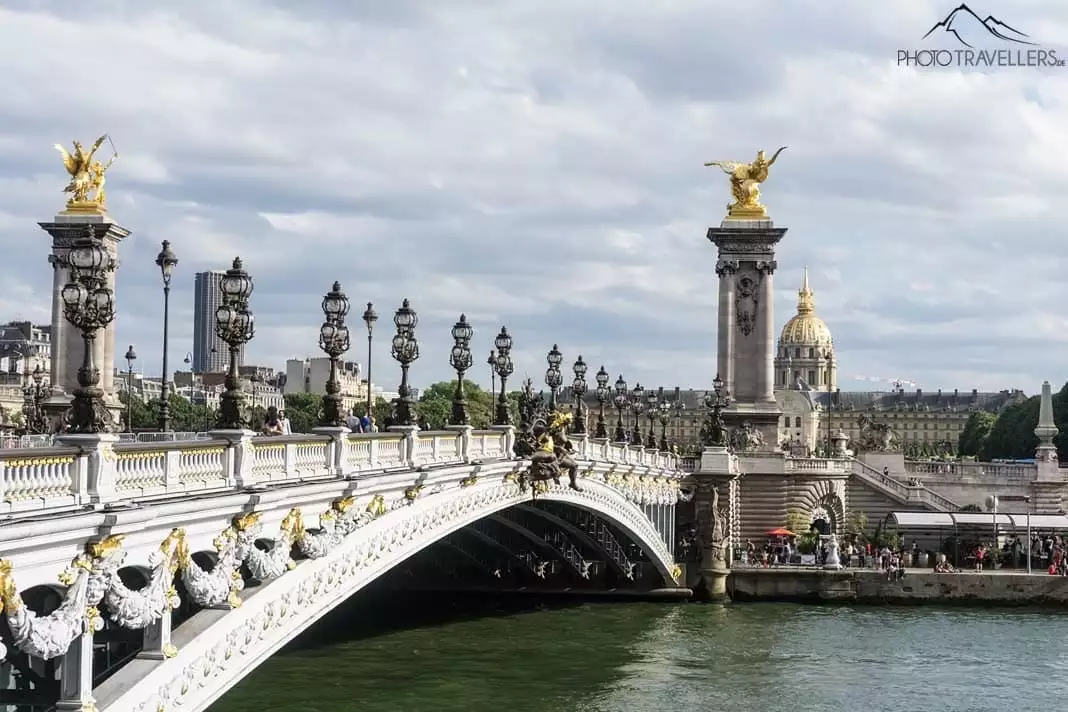
The Pont Alexandre III is dedicated to Tsar Alexander III. The Tsar was part of the French-Russian alliance sealed in early 1894. By the way, the bridge is 160 meters long and 40 meters wide and definitely the most magnificent in the whole city. Lots of stucco, lots of gold, and lots of lanterns line the bridge.

In the middle, there are two columns with golden figures. From the bridge, you have another great view of the Eiffel Tower. Directly behind the Pont Alexandre III is the military museum, the Musée de l’Armée. With its golden dome, it is impossible to miss.
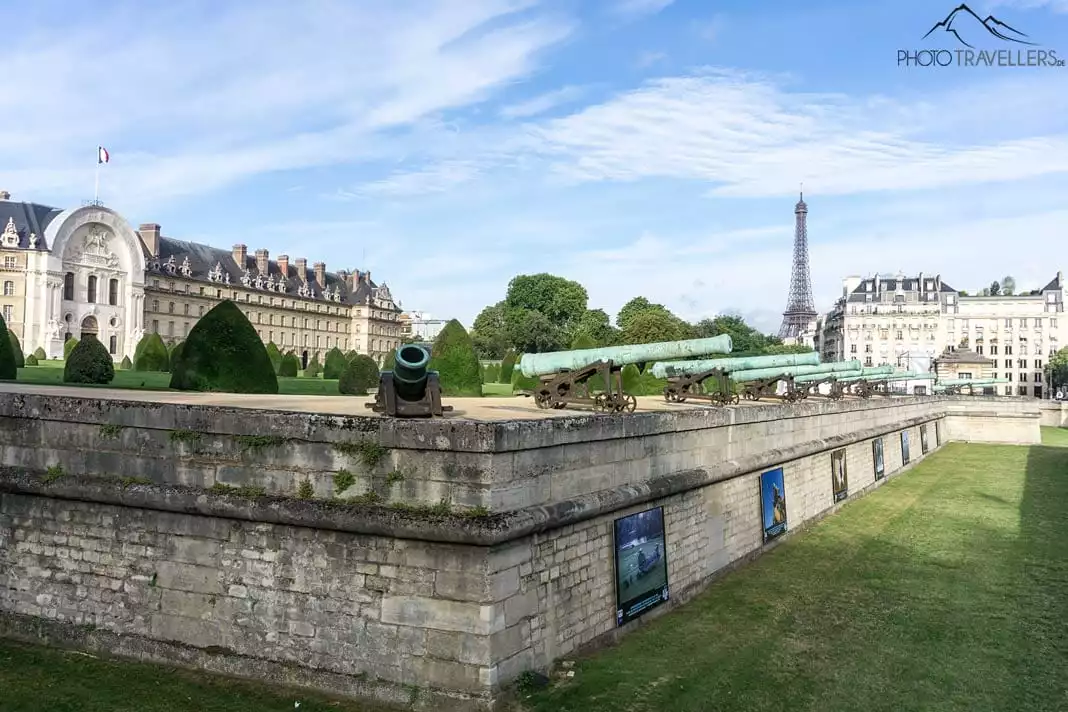
In total, you can see 500,000 military exhibits there, from the Middle Ages to modern times. On the lawn in front of the museum, in summer, many students, and tourists lie and sunbathe, enjoying wine and baguettes.
18. Eglise Saint-Sulpice
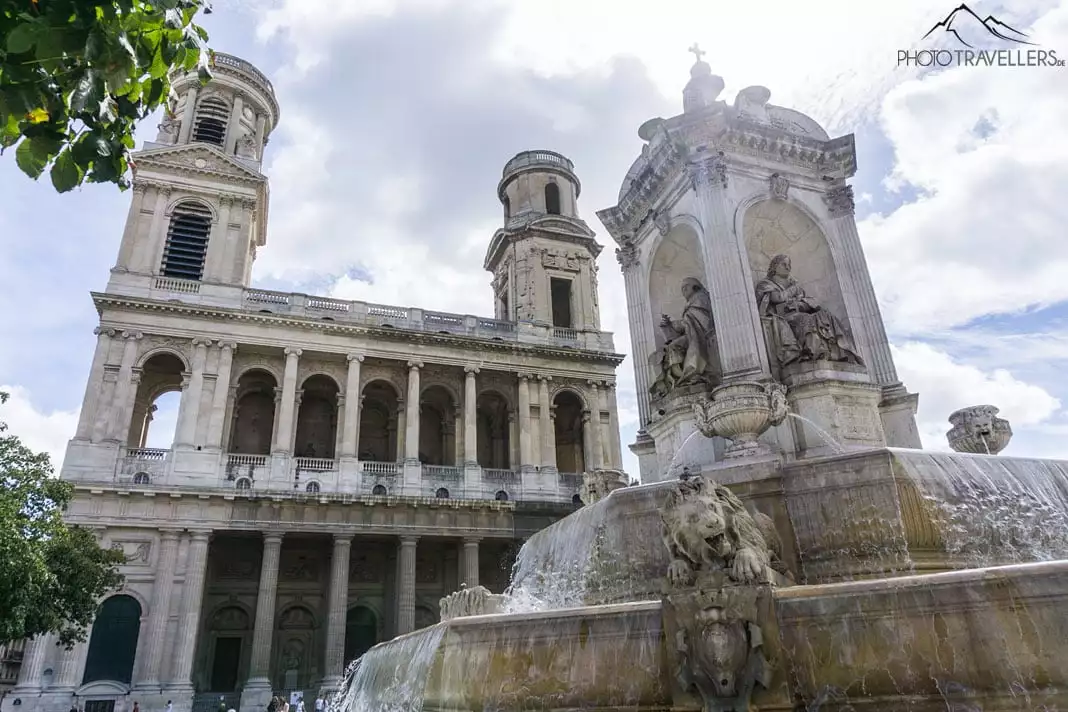
The Eglise Saint-Sulpice is the second largest church in Paris after Notre Dame and is also worth seeing. I was especially impressed by the church ceiling inside. The shapes and stones look great. There are also several crypts under the church. By the way, Heinrich Heine got married in Saint-Sulpice. There is also a beautiful fountain right in front of the church.
19. Metro stop Arts et Métiers
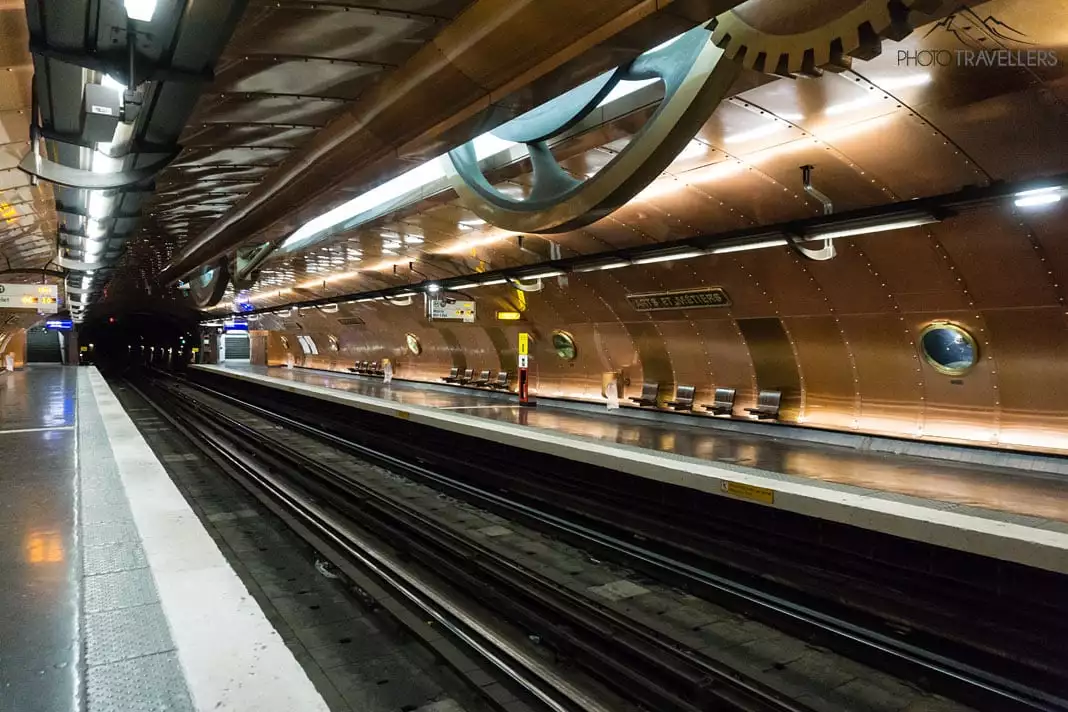
Another beautiful place you should definitely see is the Arts et Métiers metro stop. The design matches the nearby museum of technology. Everything is reminiscent of the fictional submarine Nautilus from the novel by Jules Verne. If you’re in the neighborhood: definitely check it out!
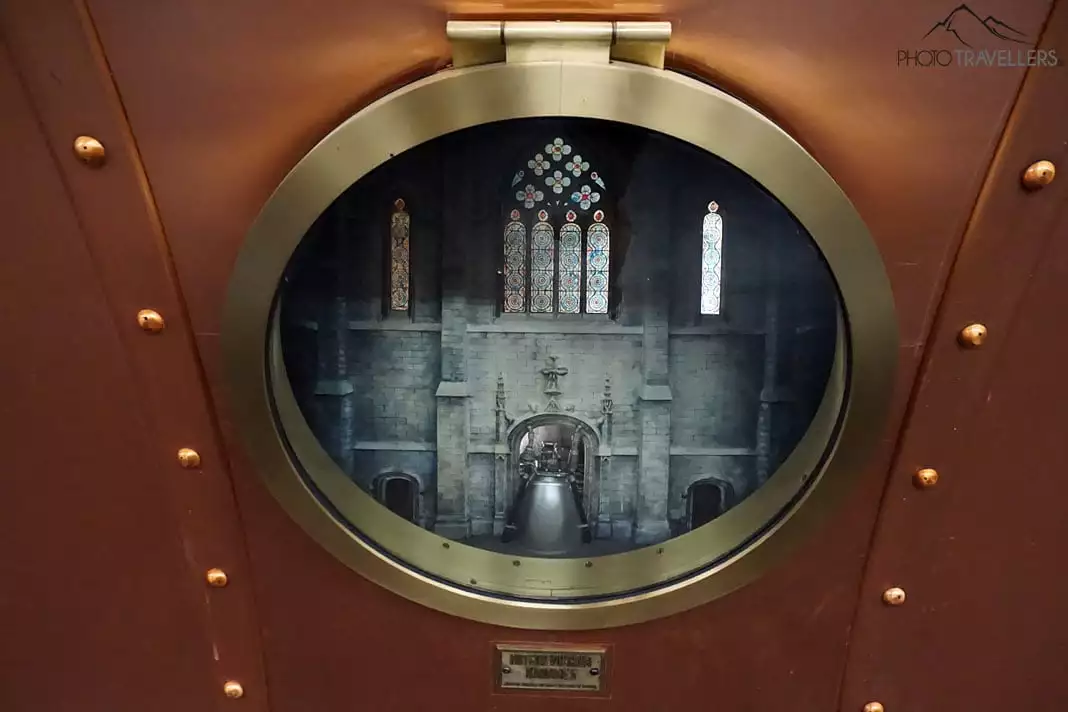
20. Tour Saint-Jacques
The 51-meter-high Gothic-style Tour Saint-Jacques (in the 4th arrondissement) is visible from afar and is one of the most famous landmarks in Paris. The tower is what remains of the Église Saint-Jacques-de-la-Boucherie church – the church for the butchers of Paris.
310 steps lead to the top of the tower. What makes the tower so impressive are the figures that crown its corners far above. Symbolic animal figures from the Revelation of John, eagle, lion, and ox, are placed there. In addition, the statue of St. Jacob is located up there. Another 19 statues decorate the tower.
Pilgrims of the Way of St. James used to meet in the church. On October 29, 1797, the Église Saint-Jacques-de-la-Boucherie, which served as the meeting place of the revolutionary committee during the French Revolution from 1793, was destroyed.
Only the bell tower with the twelve bells remained and is now part of the UNESCO World Heritage Site “Way of Saint James in France”. There are guided tours of the tower on Fridays, Saturdays, and Sundays (from July 1 to November 4); otherwise, unfortunately, it is not possible to visit the tower from the inside.
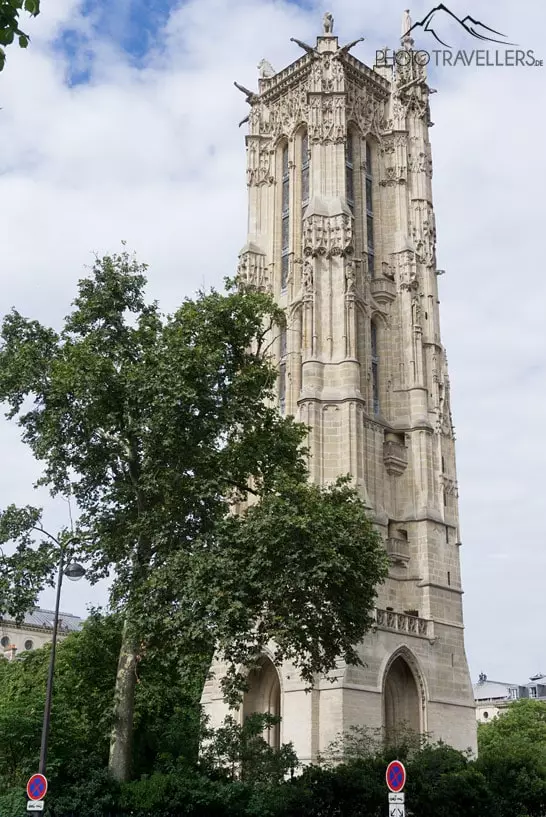
21. Rue des Halles 8 – Rats
A very special place is Rue des Halles 8. Those who have seen the movie Ratatouille know what is coming now. If you haven’t seen the movie, you should check it out when you get a chance. Rue des Halles, number 8, is home to an ancient store that carries everything needed to put an end to rats in Paris.
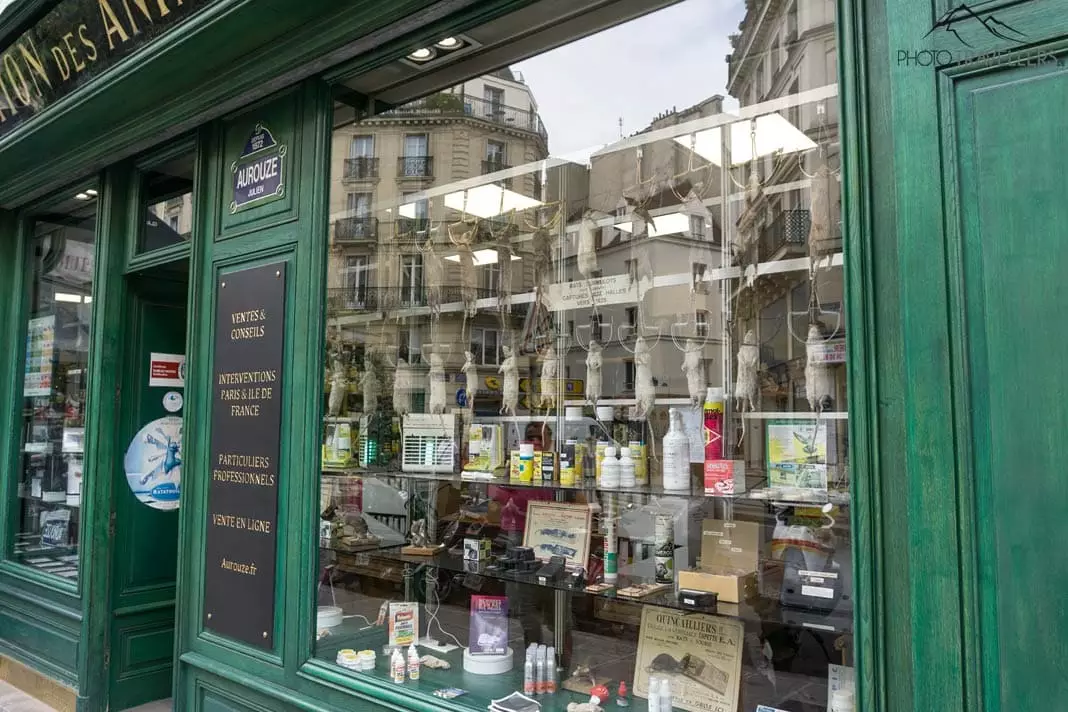
The store is called “Les Etablissements Julien Aurouze“. Stuffed rats hang in rat traps in the shop windows. This scene also appears in the movie Ratatouille, which is about a rat who becomes a master chef in a starred restaurant. The showcase is quite macabre but steeped in history. The rats are from 1925 in Paris. So small, dead, stuffed celebrities to admire there.
22. L’église de la Madeleine
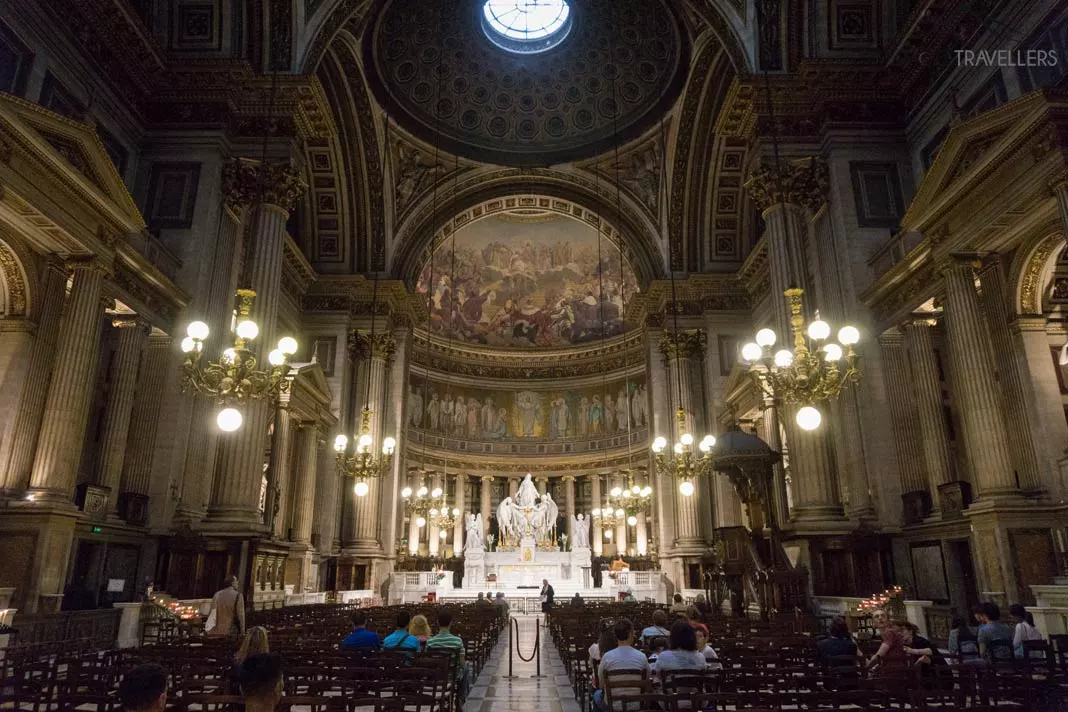
From the Place de la Concorde, a street leads to the L’église de la Madeleine. It is a church that looks like a Roman palace. The structure has eight columns in the front. At first, the building was supposed to be a church.
But then Napoleon wanted a Temple à la Gloire – a hall of fame for his soldiers. Napoleon changed his mind and dedicated the building to Louis XVI and Marie Antoinette. In 1845, the magnificent building was consecrated as a parish church.
Crazy, how many also rather unknown splendor buildings are to be found in Paris, isn’t it? You just have to wander through the city with your eyes open and you will discover one sight after the other.
23. Institut du Monde Arabe
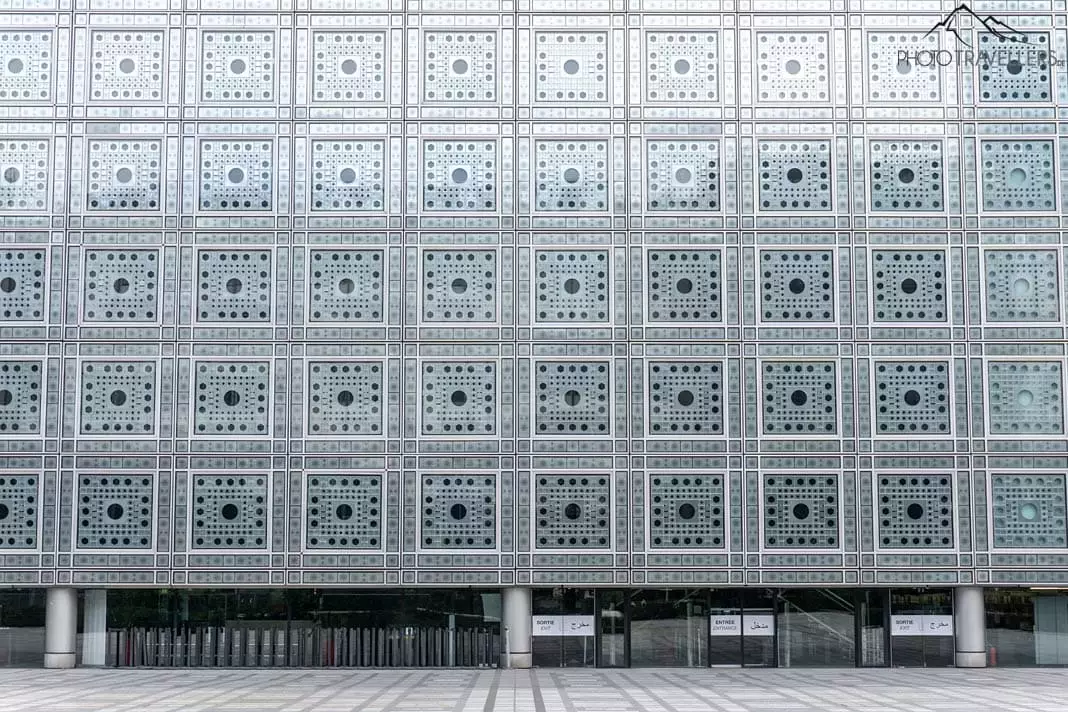
An extremely modern building in Paris is located in the 5th arrondissement. The Institut du Monde Arabe was founded in 1980 to bring France and the Arab world closer together. The rectangular building has a fascinating facade of square flaps and thousands of irises (moucharabiehs).
These open and close automatically depending on the position of the sun. The shutters go back to Arabic architecture. A very impressive building and a great photo motif in the city of love. We found this place very inspiring and are therefore happy to include the Institut du Monde Arabe in our Paris sights.
24. Jardin de Luxembourg
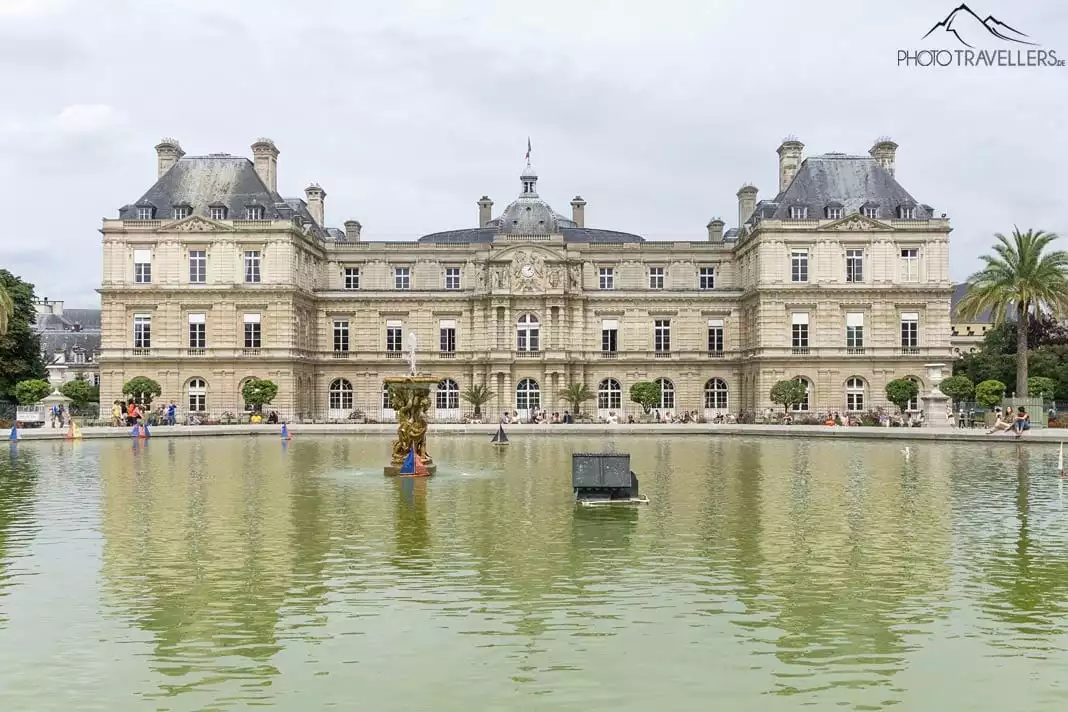
Very beautiful is also the park Jardin de Luxembourg, which is considered a promenade. Many Parisians spend their lunch break here. There are playgrounds and children can sail small boats on the lake.
According to our observations, not only the children but especially the fathers had fun. Directly on the lake is the Palais du Luxembourg – an imposing building. The entrances to the park are lined with statues and planted with lush bouquets of flowers in the summer. It’s an amazing thing to do in Paris!
25. Hôtel de Ville
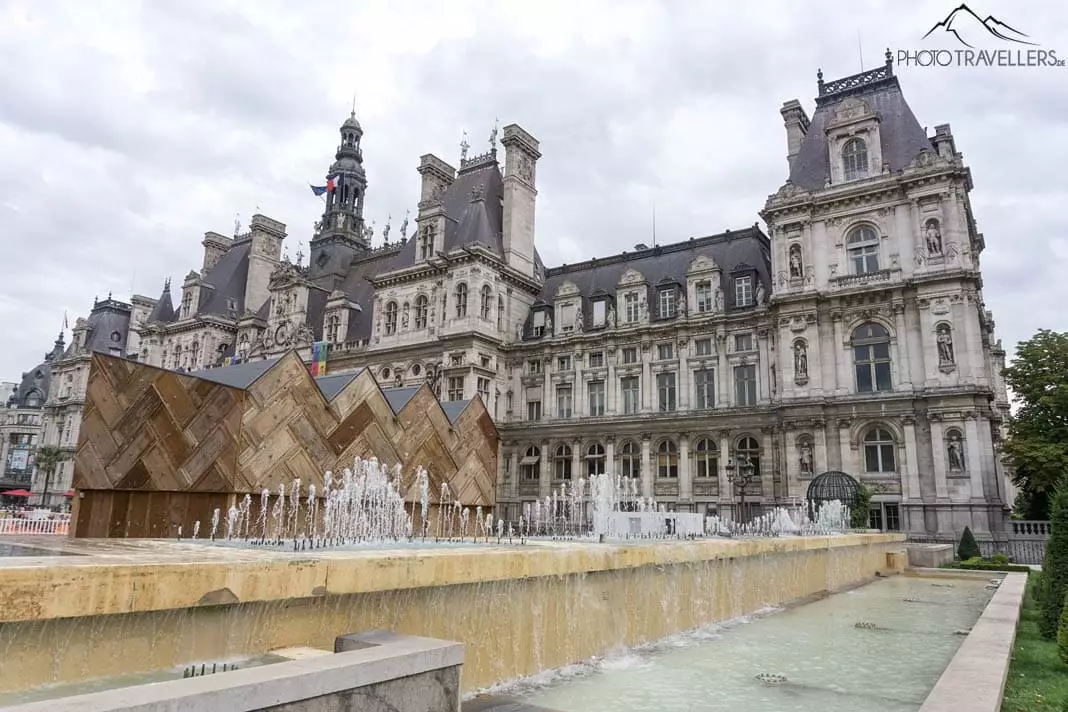
In the middle of the city, the famous Hôtel de Ville on Rue de Rivoli catches the eye. Contrary to what the name suggests, this is not a hotel but the extremely worth seeing Parisian city hall. The imposing building was erected in the second half of the 19th century in the neo-Renaissance style. The pompous building is decorated with 146 statues.
The square in front of it is called Sand Square because the shore here used to be very flat and sandy. It was also a port and landing place for all of Paris.
Insider tips from real Paris insiders
My absolute favorite is the Grandcoeur (41 Rue du Temple, website). It’s very posh and has a terrace. Simply beautiful. But Les Enfants Rouges (9 Rue de Beauce, website) is also great. Chef Daï Shinozuka combines French cuisine with Japanese. (Hotel Jules et Jim receptionist).
Really pretty is the Anne Frank park (Jardin Anne Frank – 14P Impasse Berthaud). Here you will meet many Parisians. But also the bars Little Red Door and Dragon & Phoenix are highly recommended. (Receptionist of the Hotel Jules et Jim) Shakespeare and Co (37 Rue de la Bûcherie, website), a library with great tea and coffee selection.
Alexia L’éventail (28 Boulevard Voltaire) near Rue Oberkampf has good drinks, and Aux Deux Amis (45 Rue Oberkampf) has great organic wine. Alexia
Hotel tip: Here we stayed in Paris
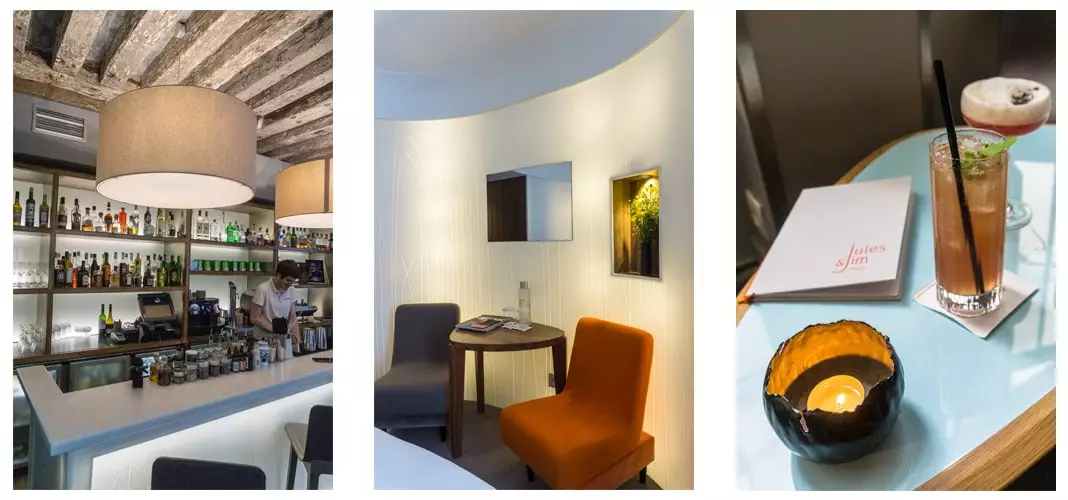
On our Paris trip, we stayed at Hôtel Jules et Jim. The design hotel not only reflects Parisian chic but also provides cultural enjoyment with changing photo exhibitions. In addition, there is also one of the best cocktails in the city in the bar – at least we think so. A visit is always worthwhile and the hotel is the perfect tip for a trip to Paris. You can book this gorgeous hotel here*.
Extra tip: Cycling through Paris by bike
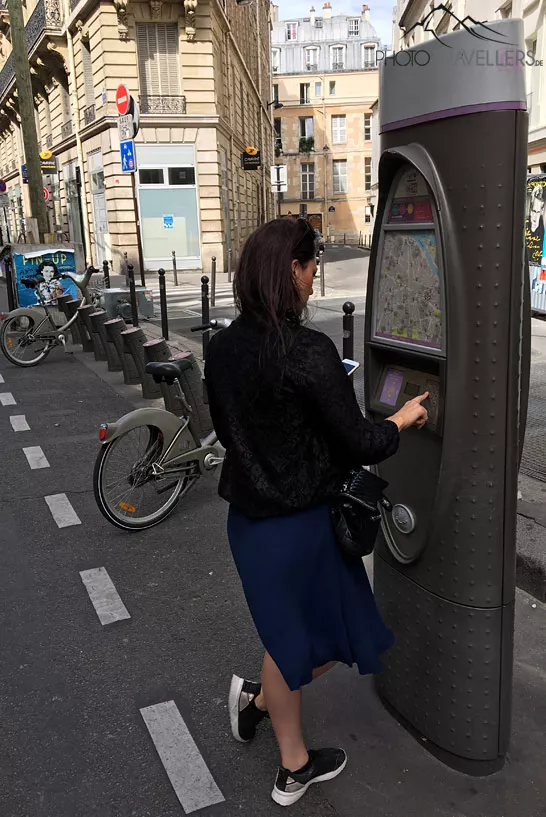
Follow our lead and rent a city bike in Paris. Why? Because it’s more time-saving to cycle from one sight to the next highlight. Plus, you’ll see a lot more and be more flexible than if you use buses and trains. We used the offer of the bike rental provider Velib Metropole.
The day ticket for the rental bike (you can rent up to five bikes at once for friends and family) costs five euros. This includes the first half hour of rental. The rental starts when you take a bike from the rental station and ends when you put the bike back into the rental station.
If you ride longer than half an hour, it costs extra. But don’t worry, you can easily get from one sight to the next in less than 30 minutes. There are also e-bikes – but they are a bit more expensive. There are other offers besides the one-day ticket for five euros.
However, the Velib bike rental is not perfect. You always have to find a station where you can return the bike. To do this, you have to download an app that shows these docking stations. Sometimes the rental stations are completely empty. Or full: Then you can’t park your bike and the rental continues.
Sometimes the bikes are broken, so before you pull them out of the docking station, check if you can adjust the saddle or if anything is bent. We had difficulties with the system, especially in the beginning but we quickly realized the time savings and flexibility. You have to learn the ropes a bit but then you love the sometimes stubborn bikes.
Beware of tourist traps
As in any big city, you have to watch out for pickpockets and other unfriendly characters. One trick used by tourist rip-off artists is for someone to approach you abruptly, take your hand, and put on a bracelet without asking. This bracelet cannot be removed (at least not without scissors).
Of course, this “nice” guy wants money for the fact that you are now wearing this great bracelet. It happened to us ourselves. Except that the guy didn’t have a chance to put the bracelet on. But to do that, you have to get loud and rude at times. If strangers approach you abruptly at crowded tourist spots, be warned and don’t let them put a bracelet on you.
But don’t let the situation escalate either – the ominous sellers are clearly outnumbered. Better to “buy your way out” for a few euros than risk stress.
Facts and figures about Paris
- The roots of the city go back to the third century
- With over 2.2 million inhabitants, Paris is the fifth-largest city in the European Union
- More than 12.4 million people live in the Paris metropolitan region – only London is larger within the EU
- With around 16 million foreign tourists per year, Paris is one of the most visited cities in the world after London and Bangkok (as of 2015)
- Paris is a cultural jewel. There are about 160 museums, 200 art galleries, 100 theaters, over 650 cinemas, and more than 10,000 restaurants in the city
- The landmark of the city is the 324-meter-high Eiffel Tower
- Paris is also the city of fashion – world famous is for example the Fashion Week Paris
